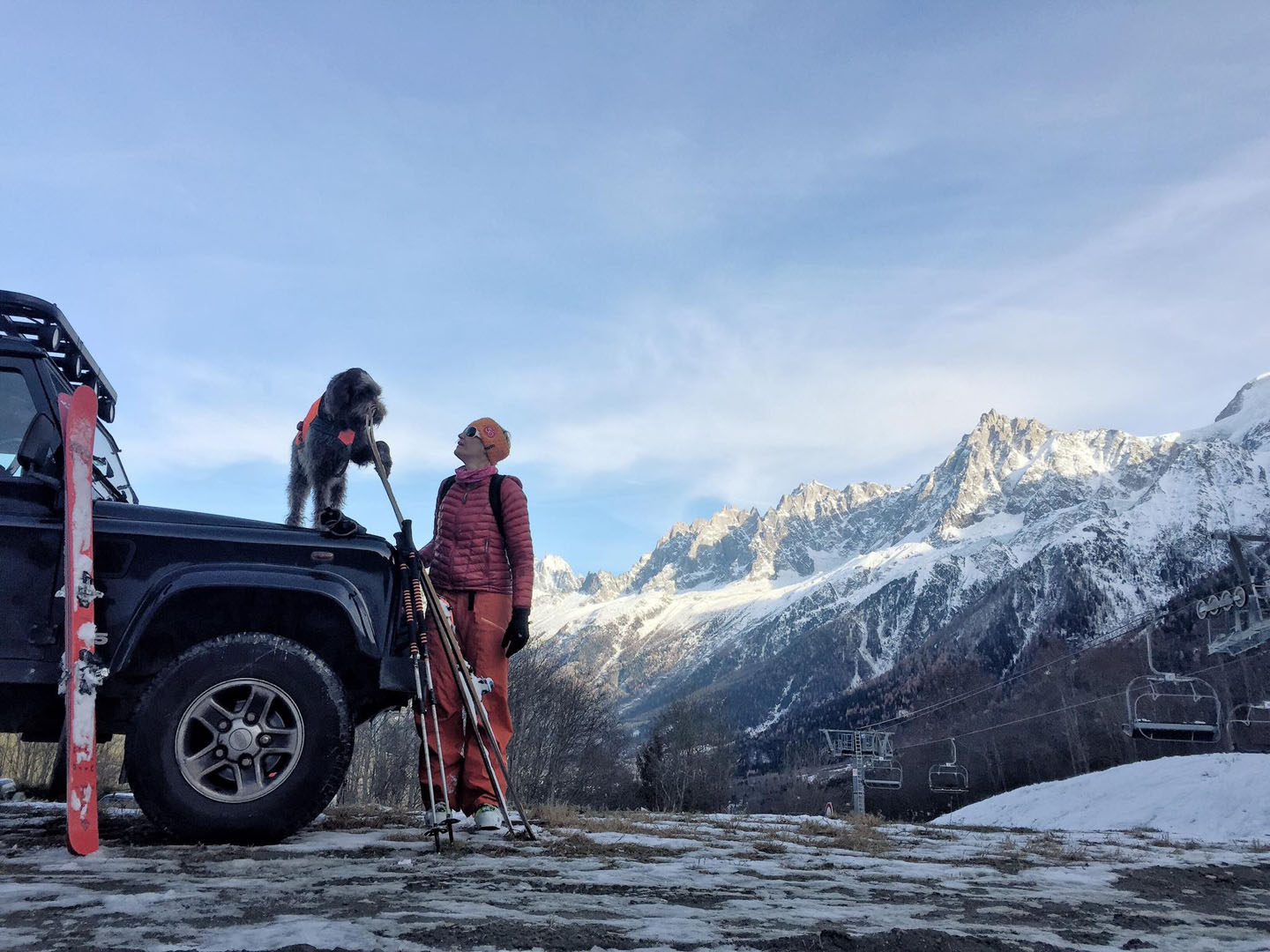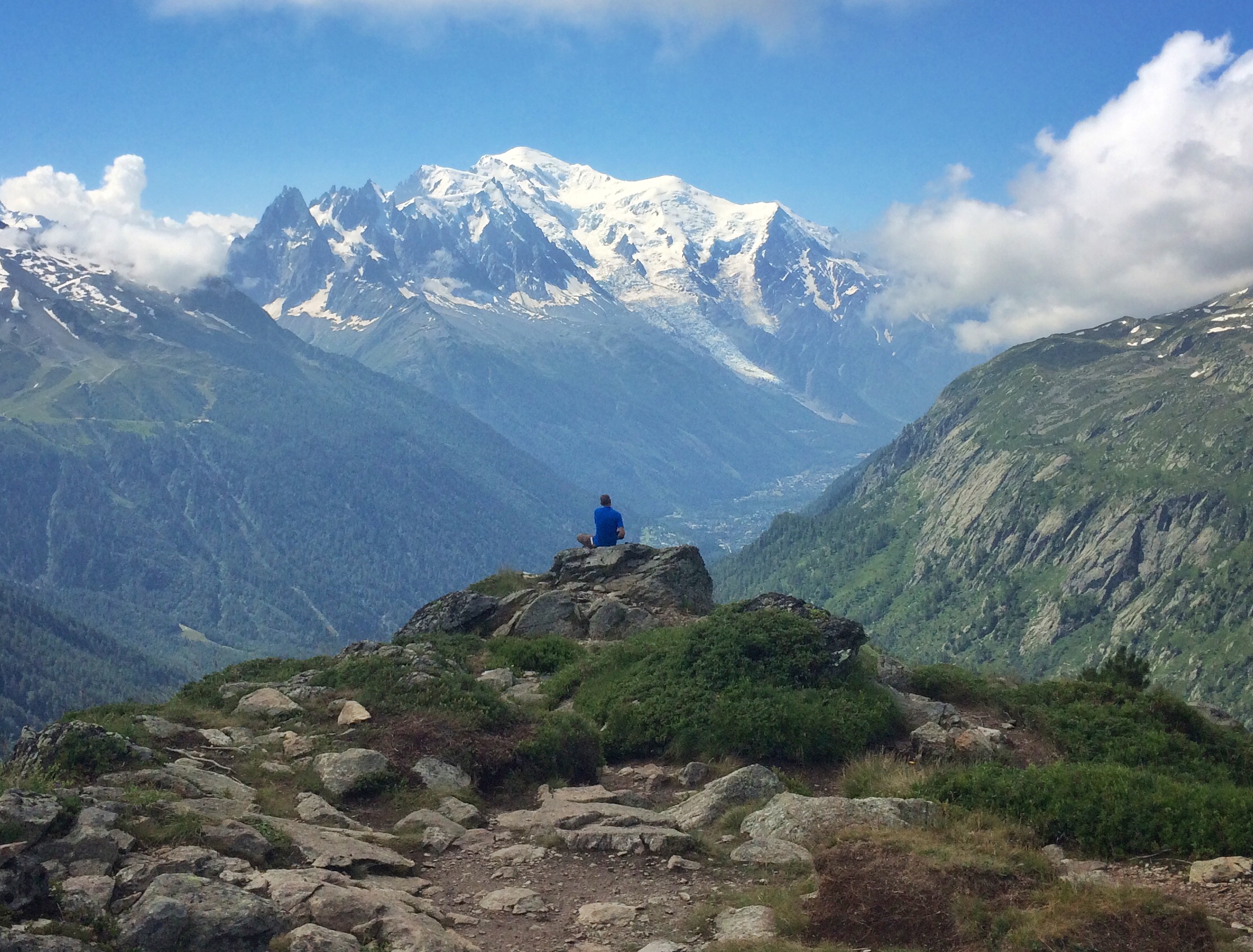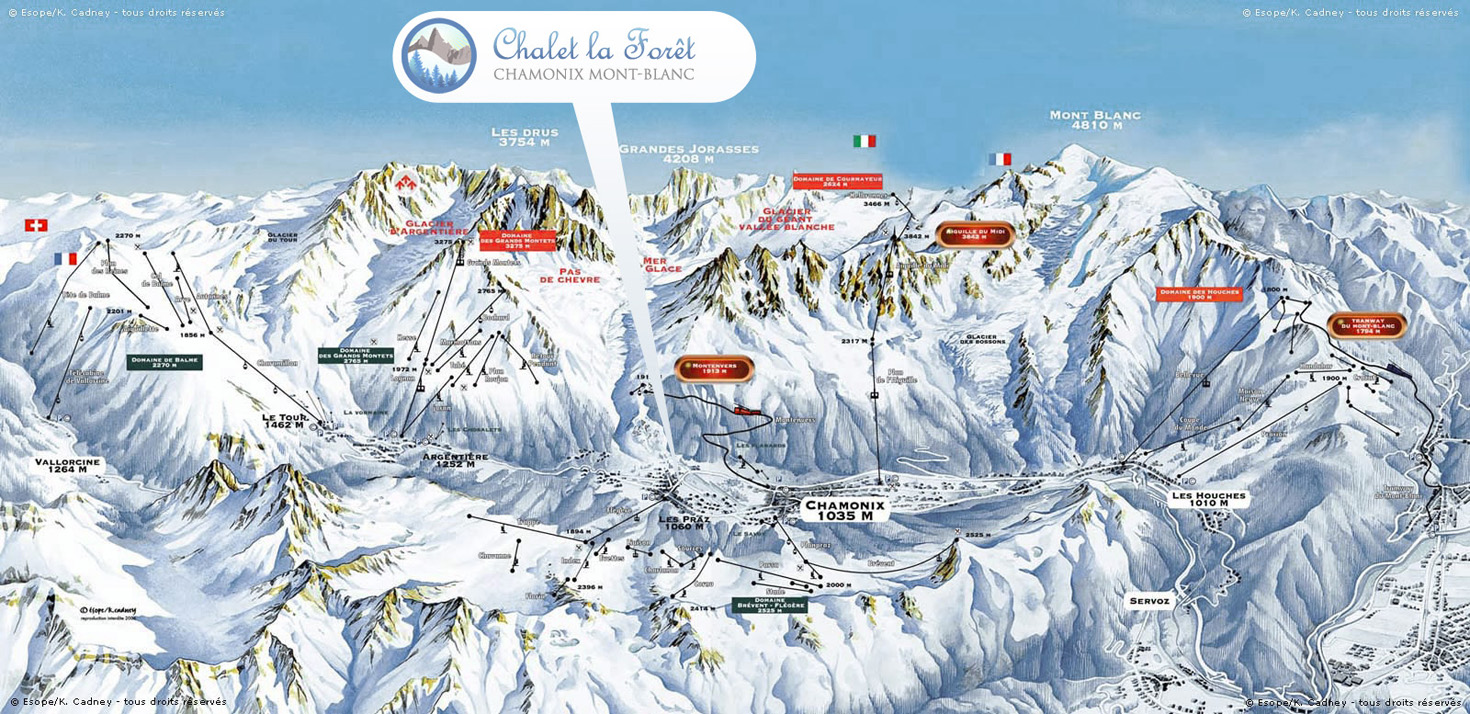Chamonix is a fantastic place for dogs in winter, just as it is in summer. This page is for winter-specific information only – please do also read my companion page for dogs in summer for more general information, vet contacts and other practicalities. Different breeds of course have different issues – an Italian greyhound can’t be treated like a Siberian Husky in this environment! And character also needs be taken into account. If you have a mellow Bernese who will enjoy an hour’s quiet valley walk, it’s quite different to bringing a lively Viszla who you want to take ski touring.
So these are general thoughts, to be adjusted according to your dog, situation, and the weather 🙂
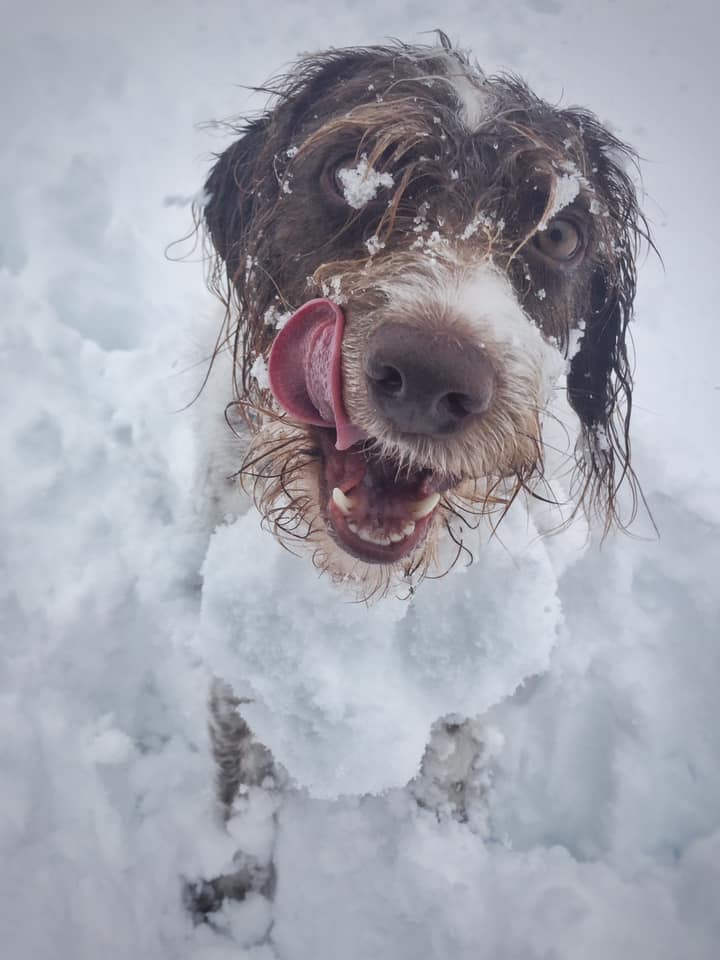
Kit for dogs
As well as the general recommendations here, there are some things that it’s extra useful to have in winter.
A lot depends on the weather of course, but a surprising amount of dogs do absolutely fine without a coat for shorter walks if they are running around and having fun, keeping warm. Check the forecast too, sometimes it is not all that cold in the valley.
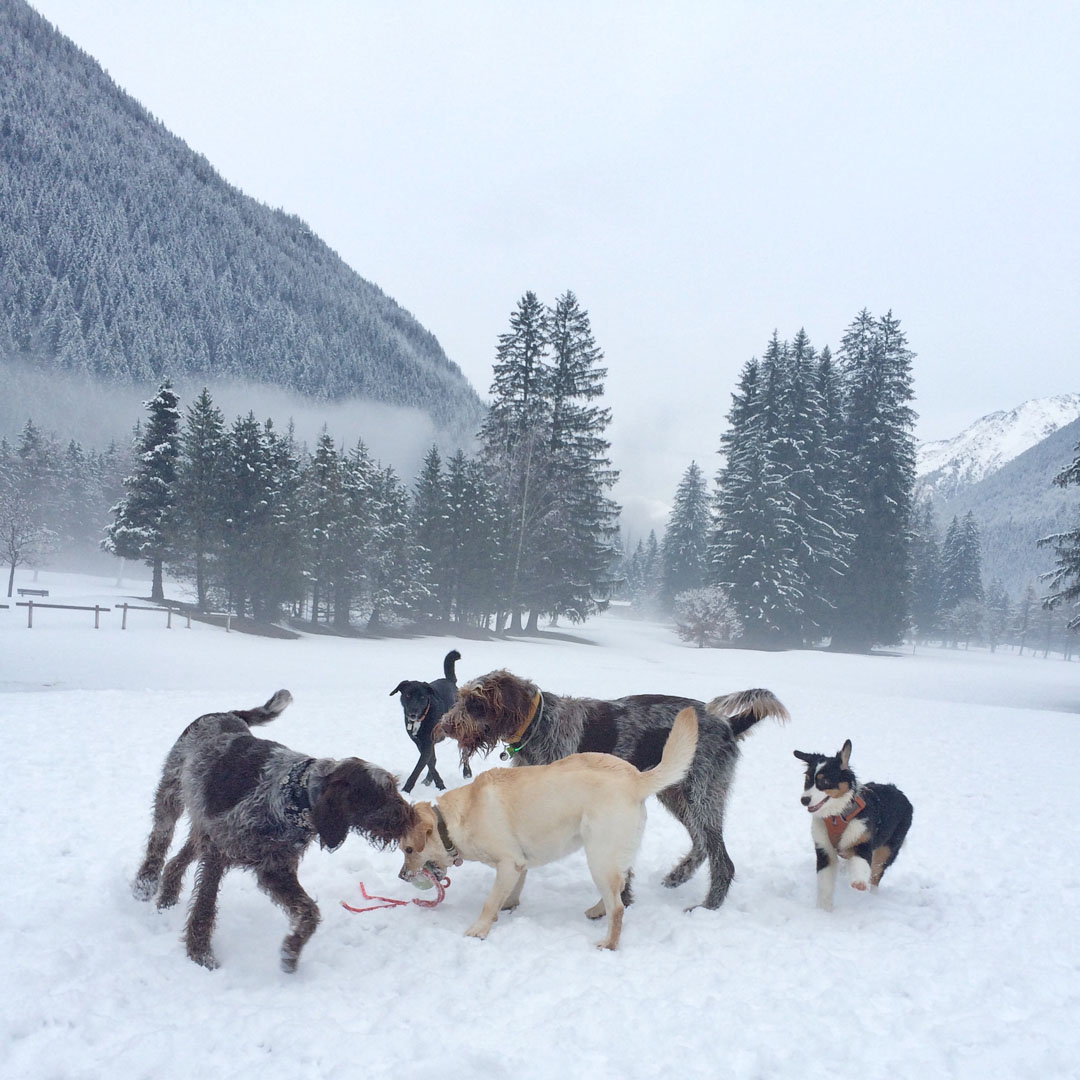
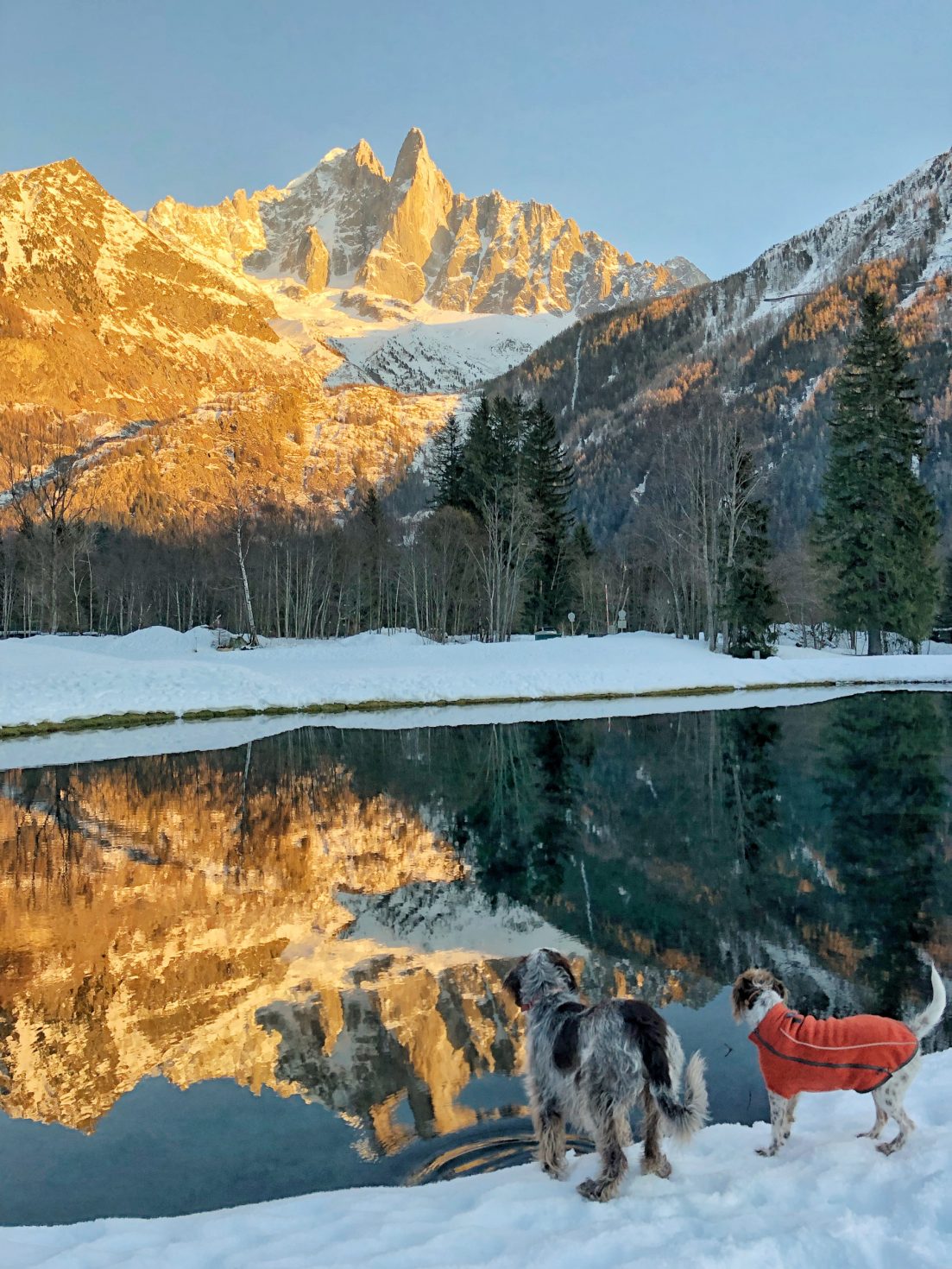
It’s good to have a bit of an idea how your dog will deal with cold before you arrive. It’s not always as simple as fine coat vs thick coat – I know some very fine coated dogs who thrive on the cold. Some dogs have very little coat on their bellies so the ‘horse rug’ style isn’t much help in the snow – you need coverage on the tummy. Some coat brands I recommend are Hurtta, Equafleece, Pomppa and Ruffwear.
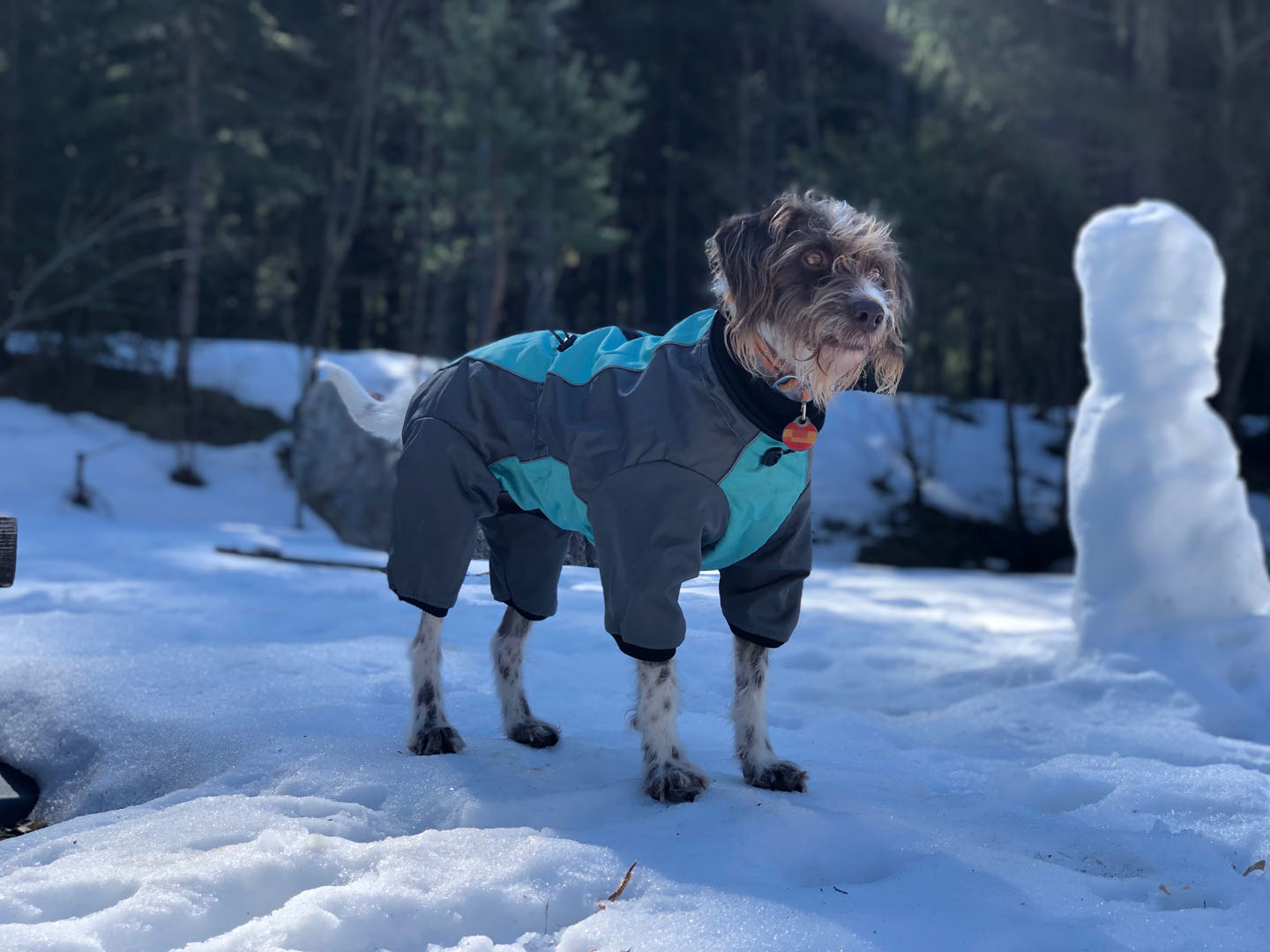
Shorter days can mean walking in the dusk or dark. Lights on a coat or collar are a very big help in locating a dog for you and for others.
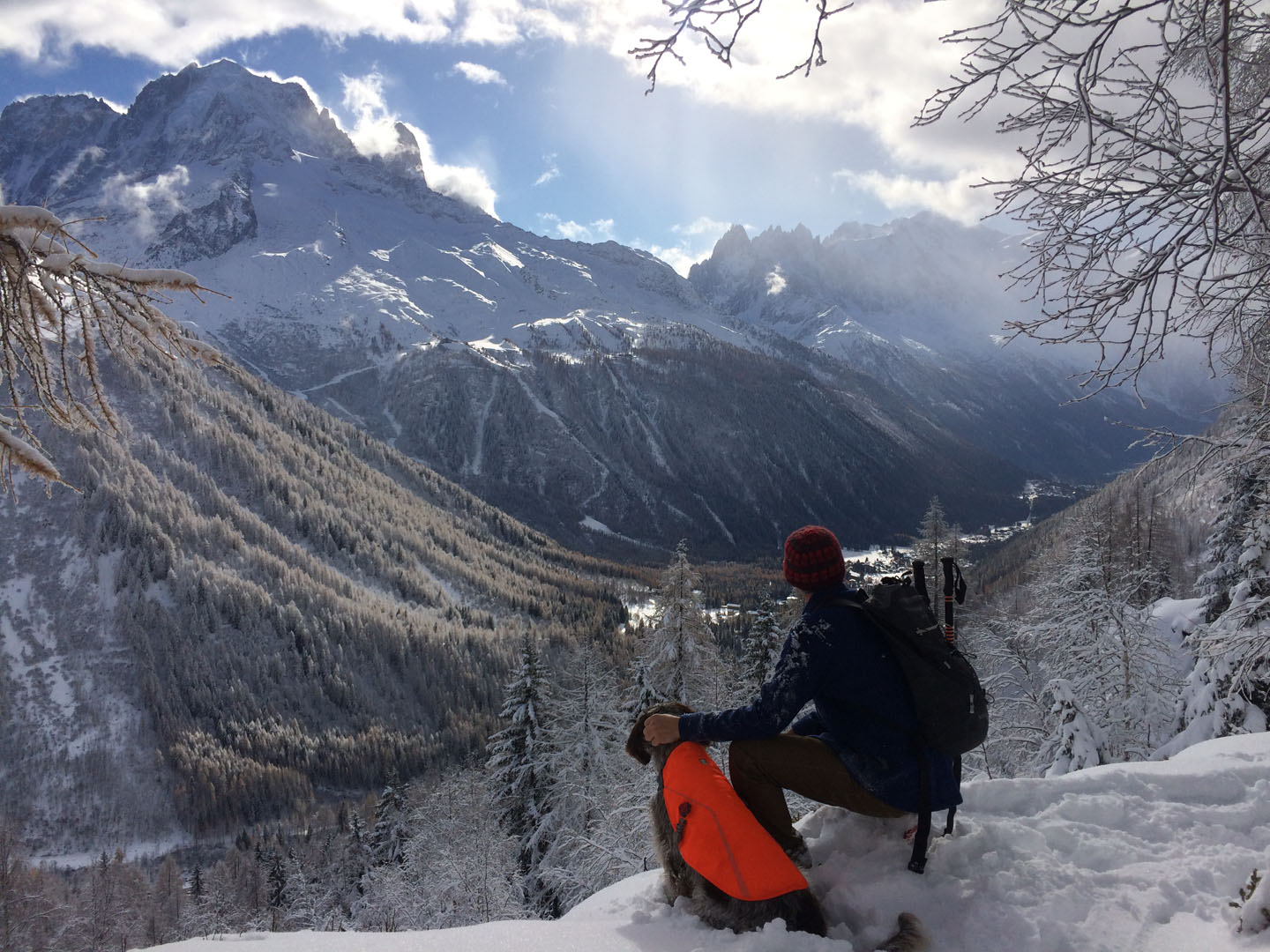
Consider using a harness if going on mountain paths or walking in the dark – you do not want a dog to slip its collar at night. Recommendations on the Summer page here
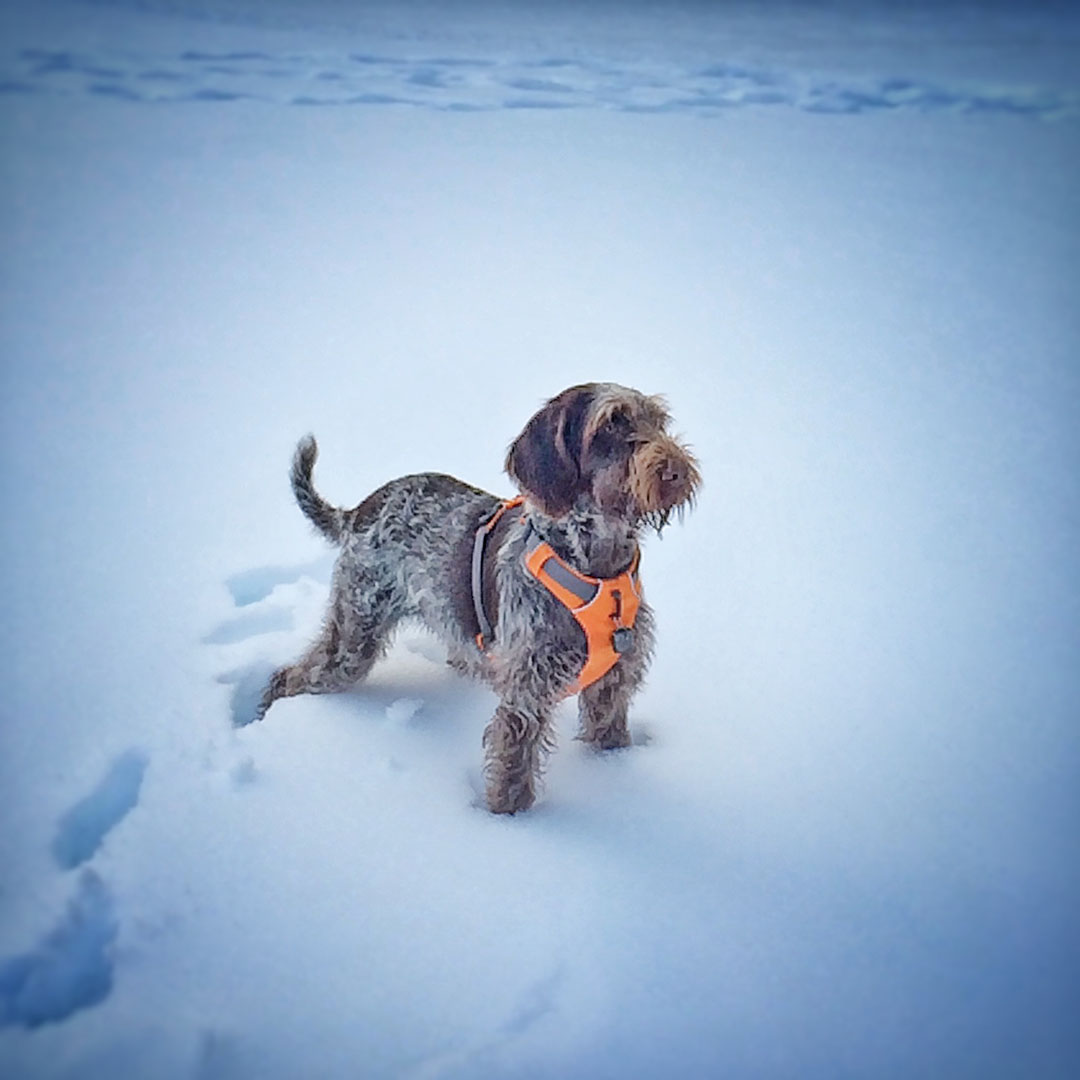
Some dogs have coats that can ‘ball up’ quite badly. A good groom and trim can be well worthwhile to prevent this.
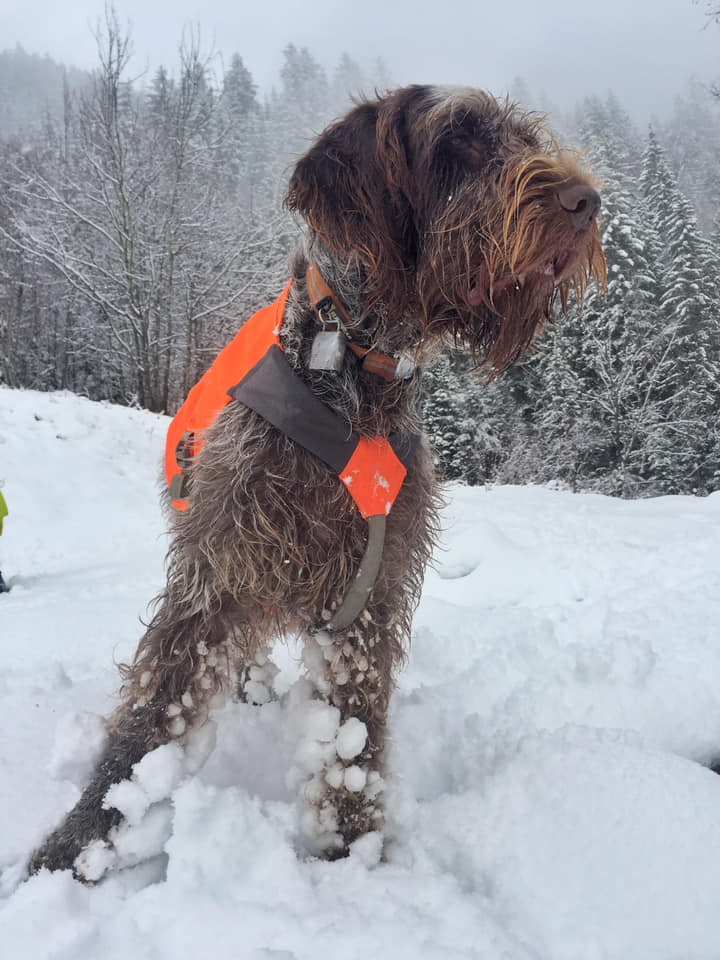
Paw wax works very well to prevent snow balling between the pads. Keep the hair between the pads well trimmed to prevent this also. “Musher’s Secret” is a good make, available locally from Cham’dog. In a pinch you can use any oil, but then they can eat it!
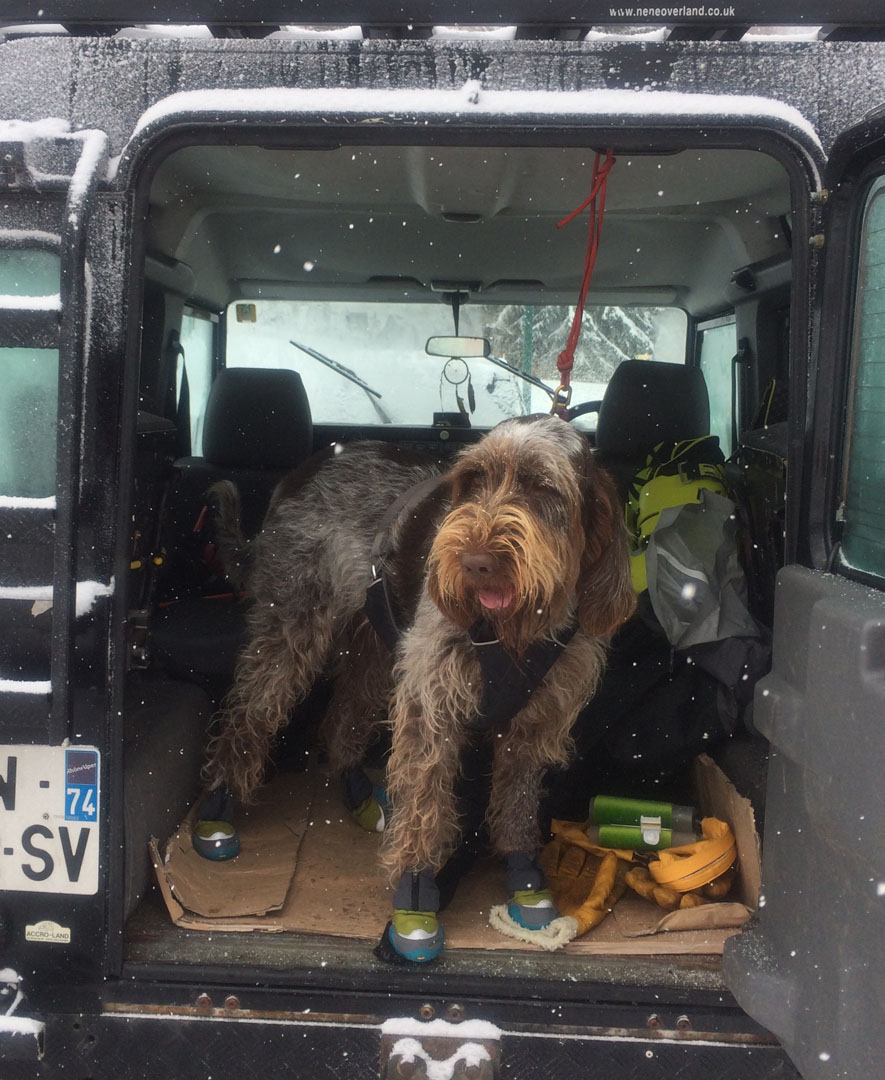
The pavements in Chamonix get salted in winter and this can make dog’s feet very sore, very quickly – to be considered if you are staying in central Chamonix. Small dogs can be carried out of town for their walk – for larger dogs you may find boots worthwhile. For occasional use you can get rubber ‘Pawz’. For regular use, Ruffwear, Muttluks or Hurtta are good brands. Do note that boots can fall off, and are expensive ! Keep an eye on them to make sure you always have all four. Bright colours are easier to find if they do fall off.
There is an unfortunate lack of bins in the dog walking areas so bring something that you can carry bagged poop in.
Winter-Specific dangers
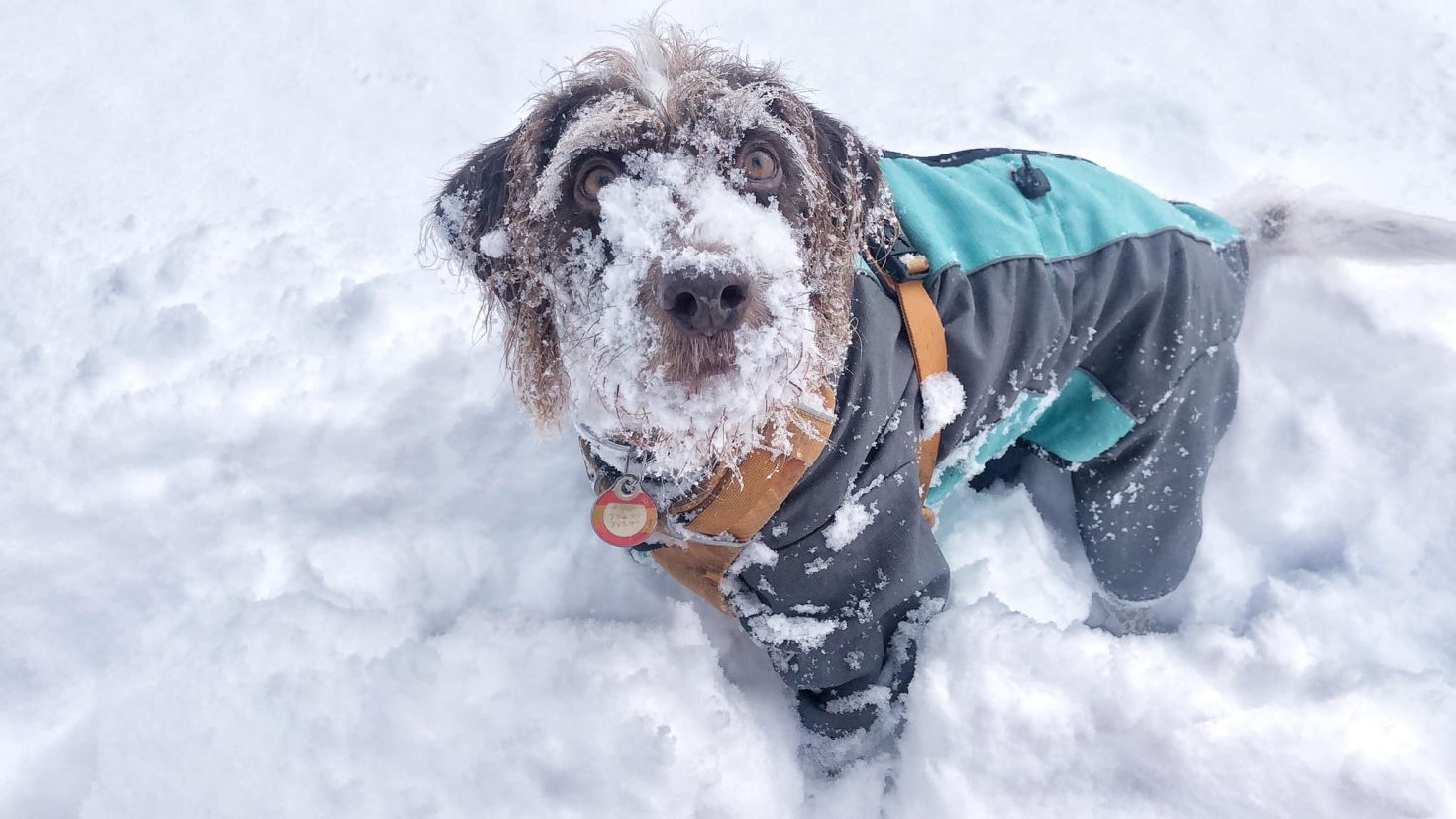
Keep an eye on your dog – smaller dogs especially can lose heat faster and may need more for warmth.
Avalanche blasting in the valley can be loud and continuous on some mornings. If your dog reacts badly to thunder or fireworks it could be better to think of leaving them with a dog sitter. Many dogs find the noise very distressing.
During winter, deer, boar and other wildlife tend to come down much lower to the valley floor. They really need their energy reserves to survive at this time, so it’s vital they are not chased by dogs. Many deer have died in the valley due to exhaustion after being chased by dogs, or been maimed or killed. I won’t distress you with photos but be assured there have been many and they are very sad to see. If your dog has a strong prey instinct, you should keep it on a lead when near woods.
Additionally, a dog that is lost in winter temperatures in an unknown environment is in a very serious situation and may not survive if out all night. If they go off chasing smells in the woods, they can fall into snow holes, streams etc and disappear completely. If you aren’t 100% about your dog’s recall, it should stay on a lead for its own safety. I recommend a GPS tracker as described here for summer, and it’s doubly useful for winter.
Hunting Season
From the second week of September to the last weekend of January, be careful as dogs, horses, donkeys and people have been killed by hunters. Not (as yet) in this valley, but in neighbouring ones. Check at the tourist office if you are here around this time. Wednesday and Friday are no-hunting days. Unbelievably, hunting is allowed on Sunday! Feel free to mention your concern at this at the tourist office.
We use a bell and a hi-vis vest (Ruffwear Track Jacket) at these times, and dress in bright colours. It’s also best to walk in the middle of the day – hunters usually are out in the morning and evening.
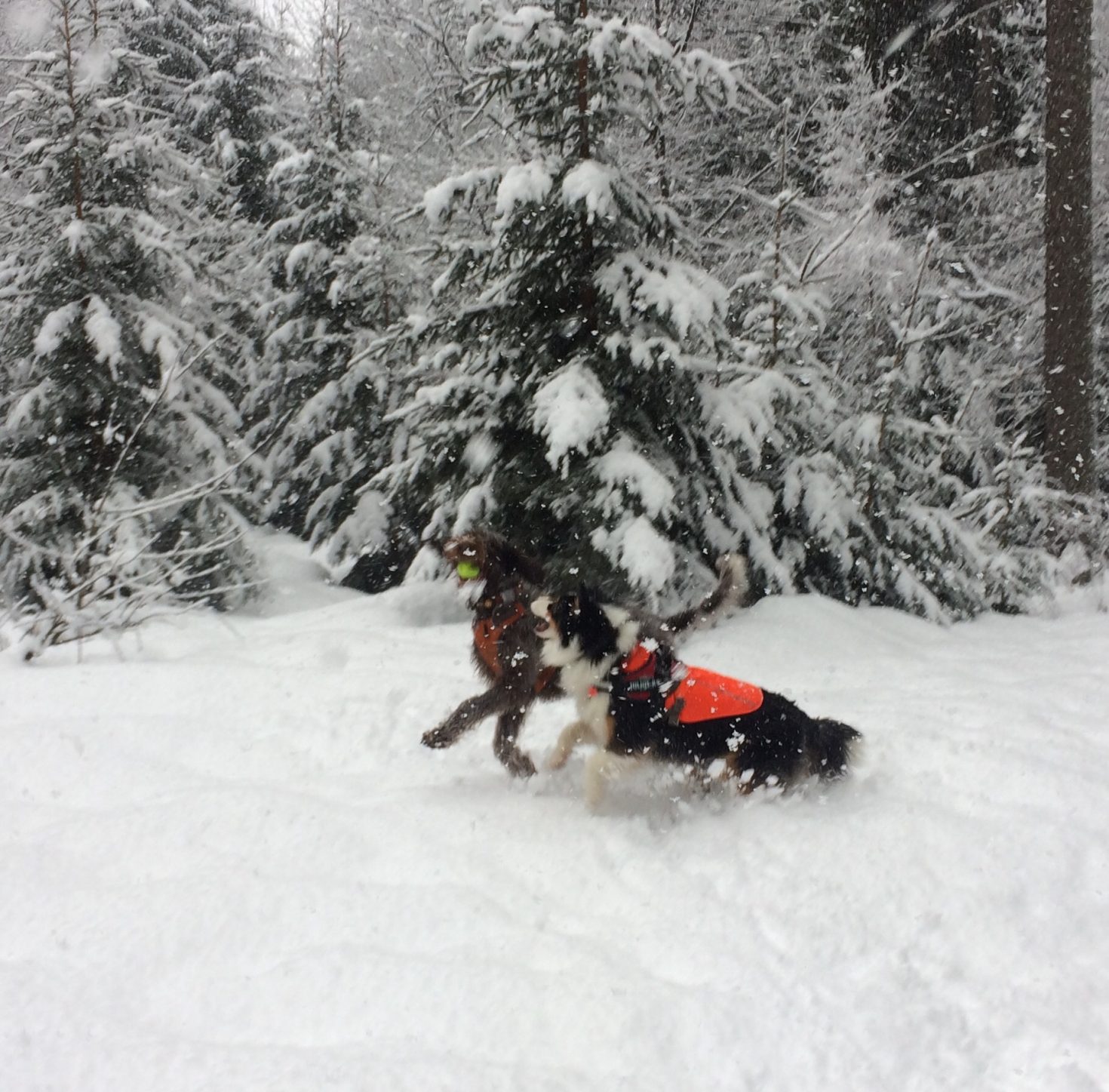
Where to walk a dog in winter
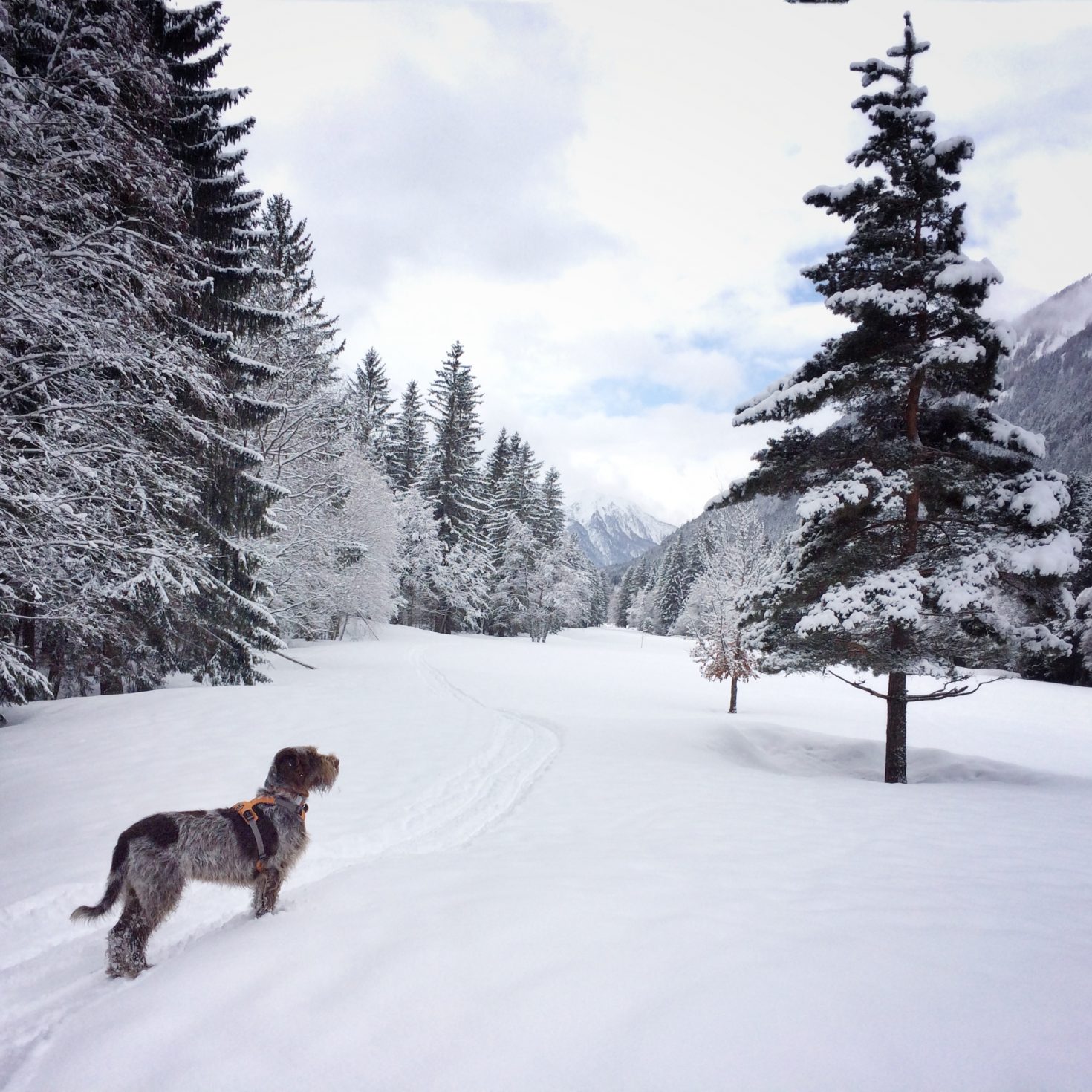
The golf course is accessible to dogs in winter and this is a perfect place to let dogs run free. You can walk to the ‘Paradis des Praz” also, a very pretty path by the river, signposted from the golf course car park.
Even the golf course can get quite deep though!
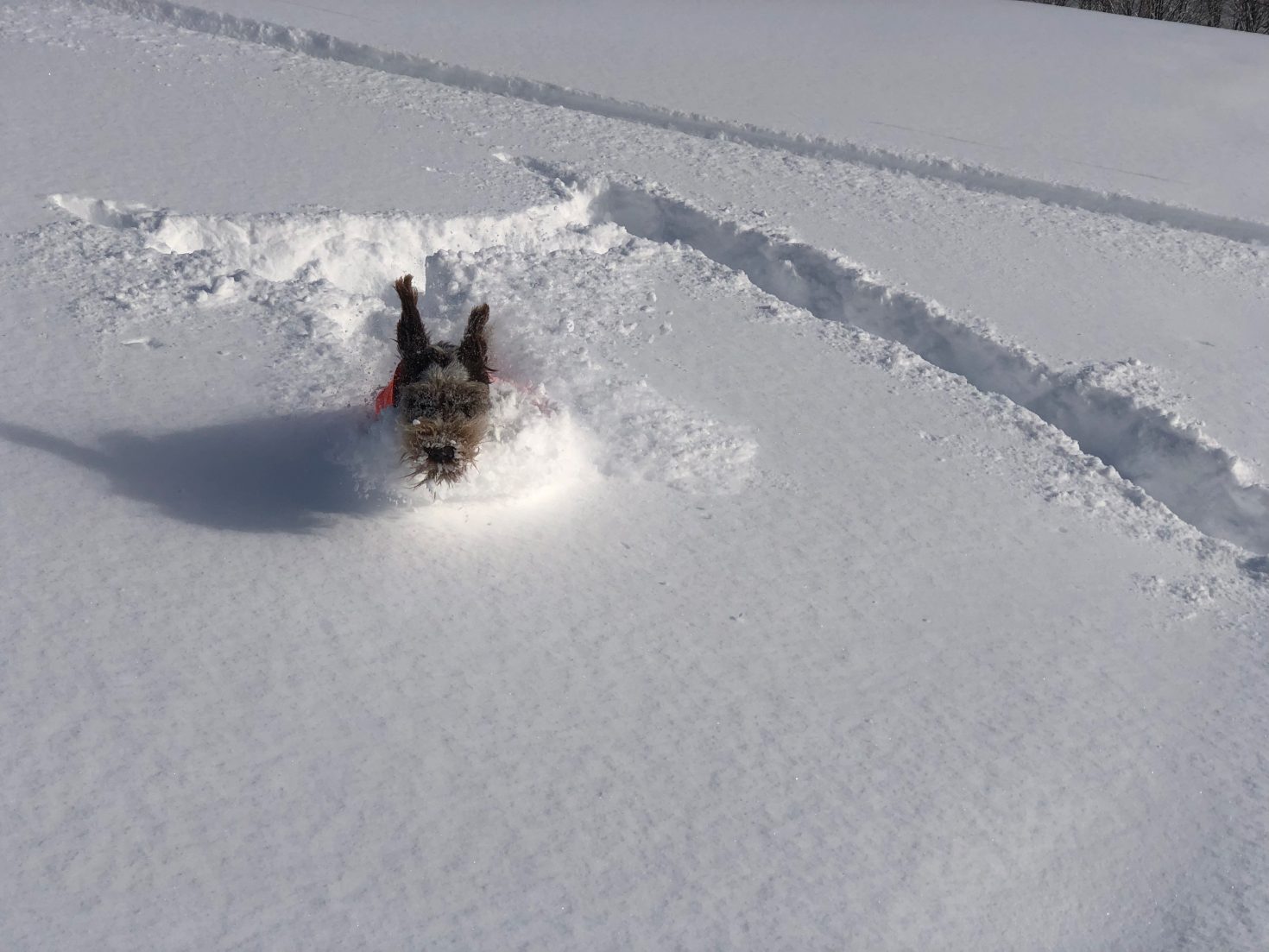
The valley floor has a network of groomed walking trails which are great for dog walking. However many of them are parallel to the cross-country ski trails, so dogs need to be on a lead in these sections as it’s very dangerous if they run amongst the skiers. Also the grooming machines can operate at any time of the day on these trails – be especially careful when walking here after the trails have closed as they will not be looking out for dogs. Many dogs find them extremely scary, so stay well back and keep a tight hold of your dog as they pass, you don’t want a collar slipped in fear.
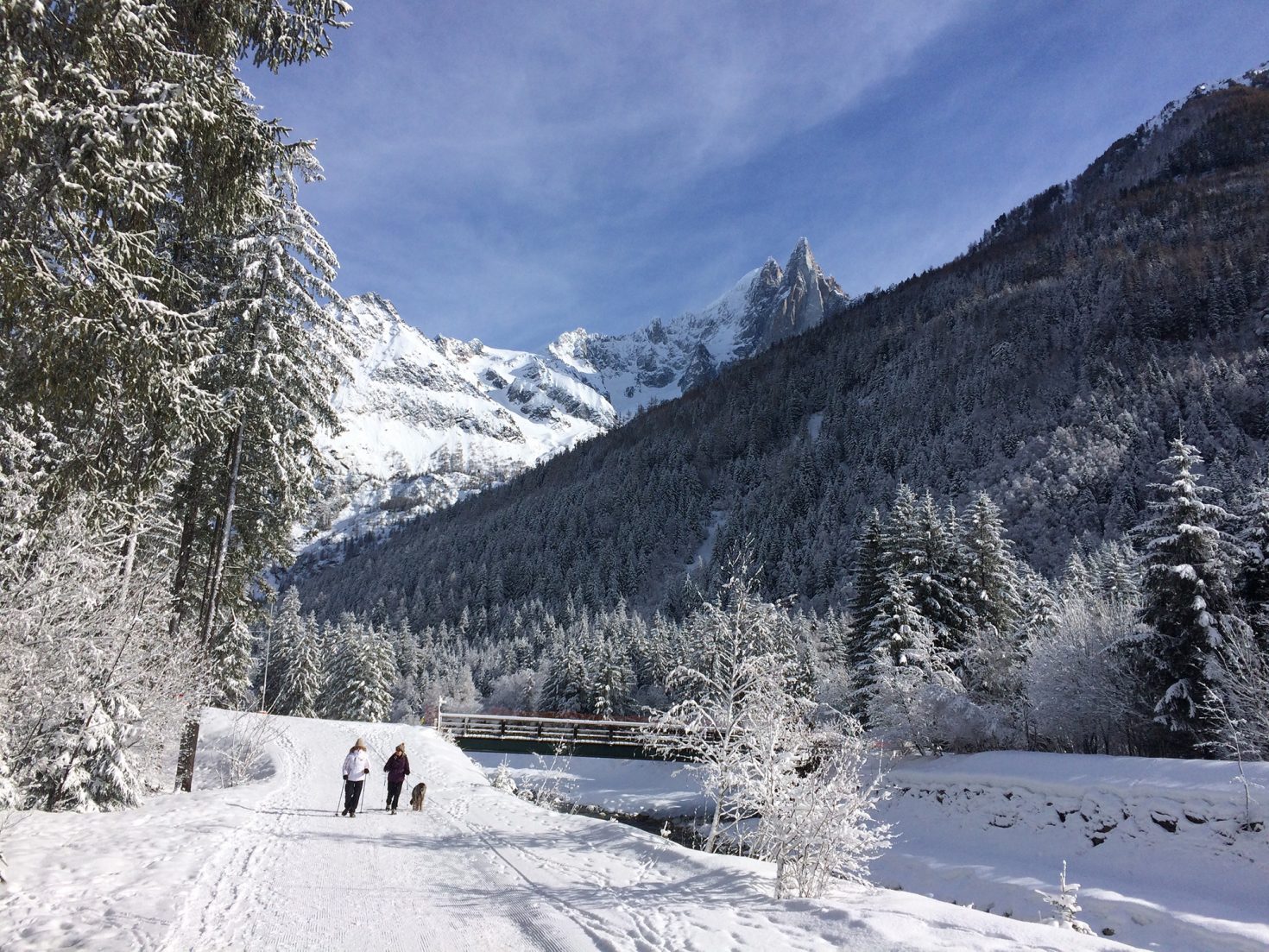
Normally, even the ungroomed paths of the valley floor are used enough that they are fine to walk on. You will want good boots that are ankle high at least.
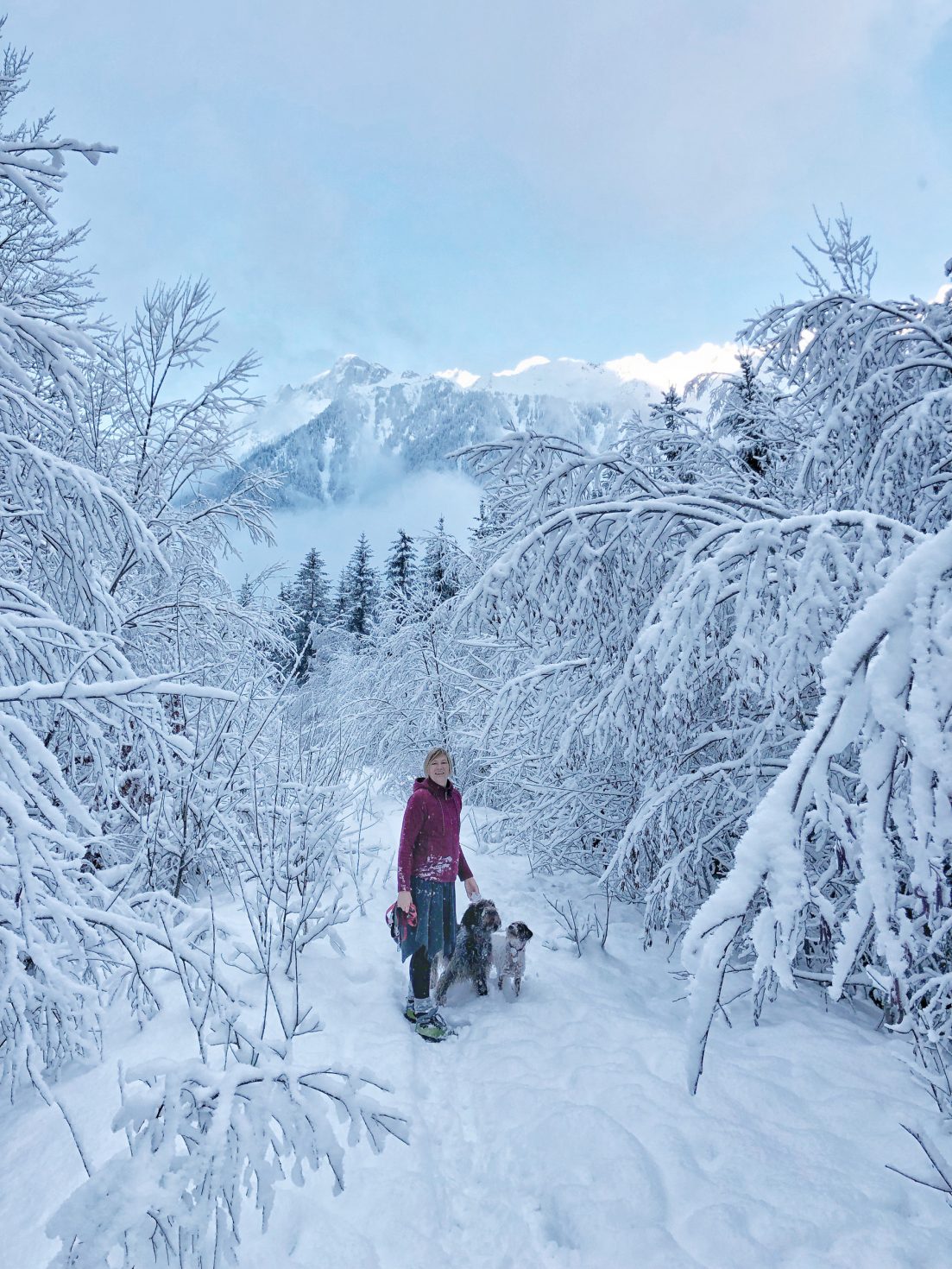
Lac Passy at the entrance to valley is a lovely place to walk dogs in winter, and doesn’t usually have much snow.
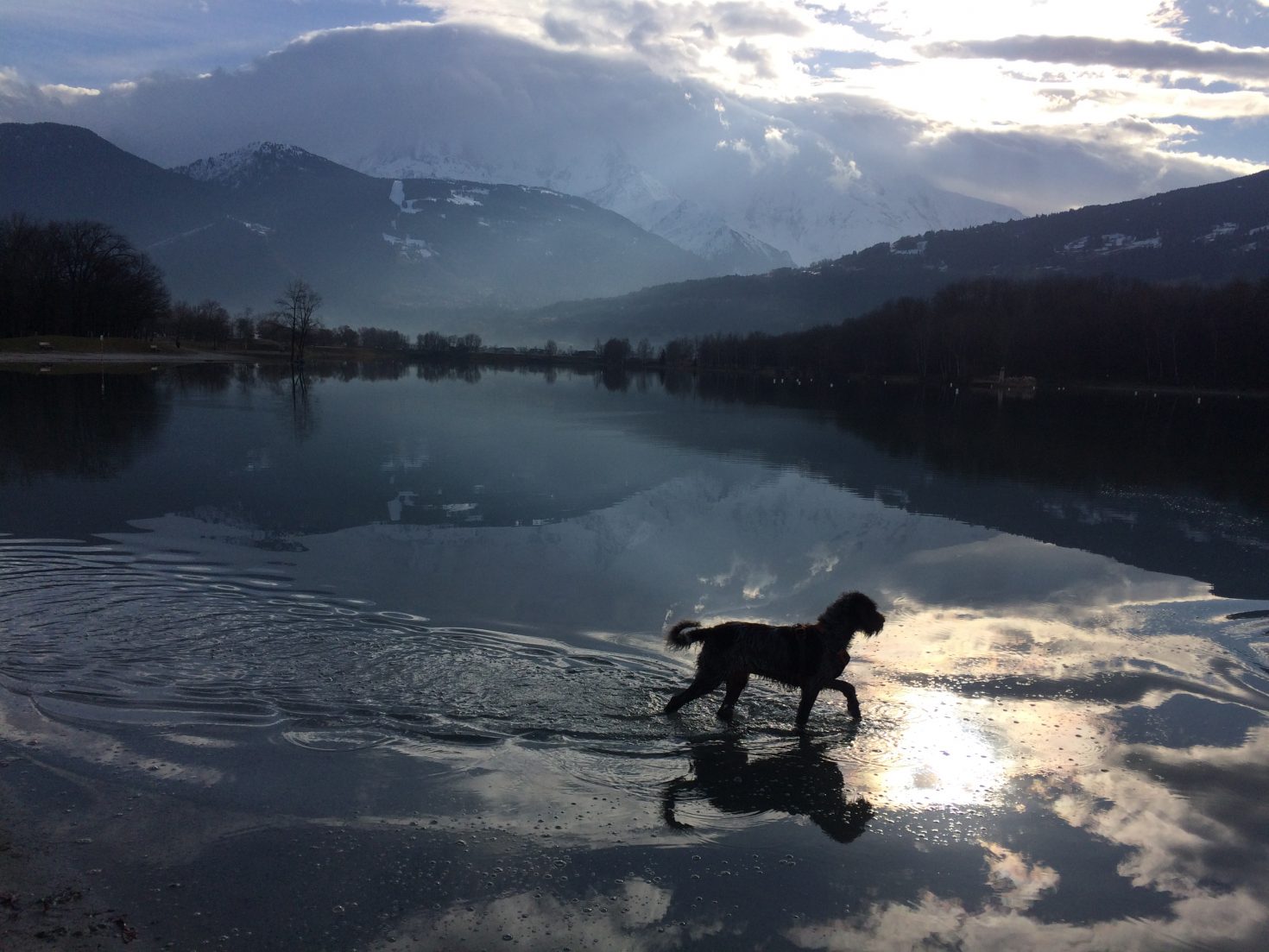
High walks / Snowshoeing
There are quite a few higher walks that are good with dogs in winter – depending on snow conditions, these can be fine with boots and perhaps snow grips, or you may need snowshoes. Poles are always a good idea. Collapsible ones are best so if you need to hold a lead with one hand, you can put a pole in your backpack.
Photos are here just for inspiration and ideas – all these walks can be inaccessible at times, and all have some element of exposure to steep areas or cliffs. Avalanche danger changes constantly. The valley floor walks are signed if there are dangers, but not any others. So always check conditions with the Office de Haute Montagne before setting off.
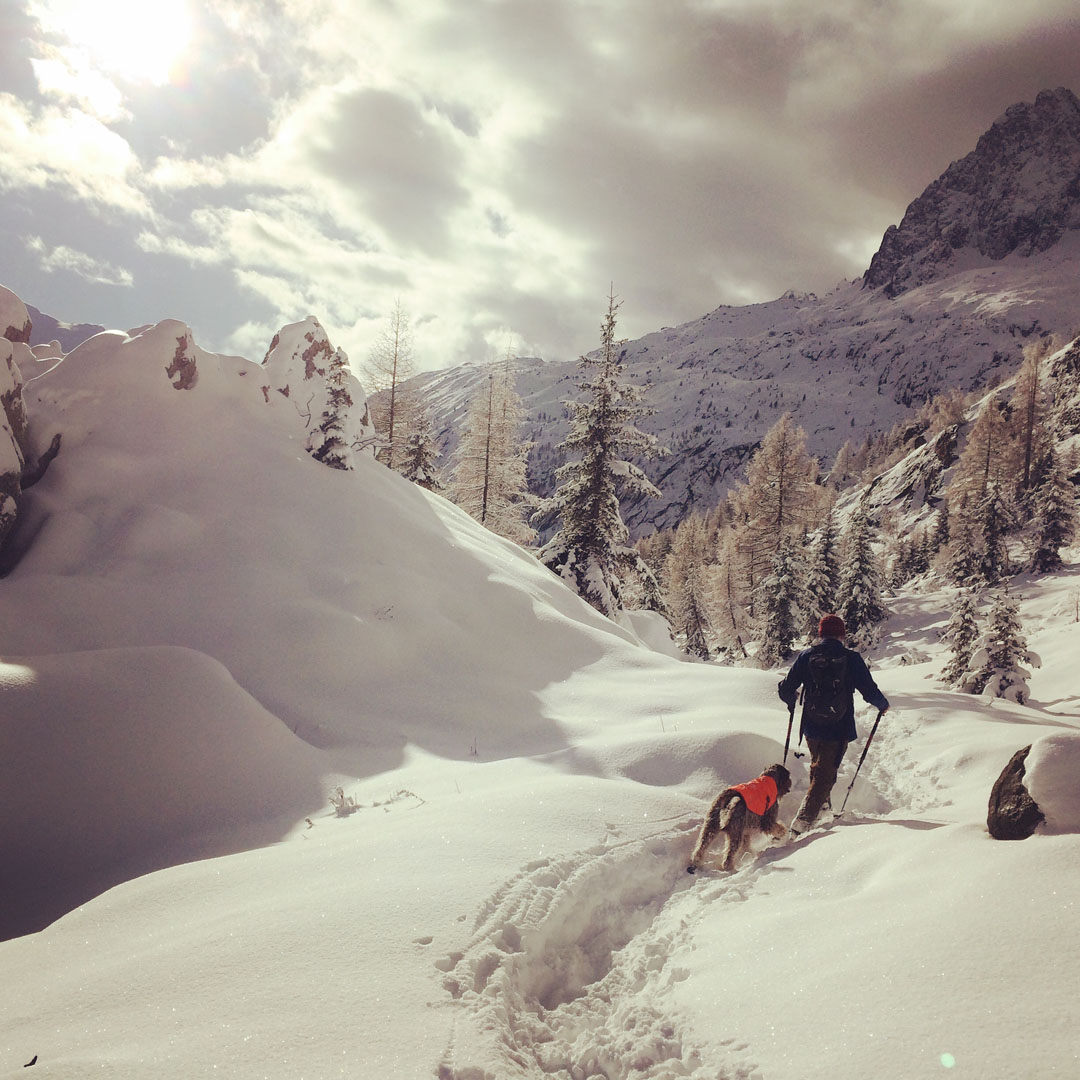
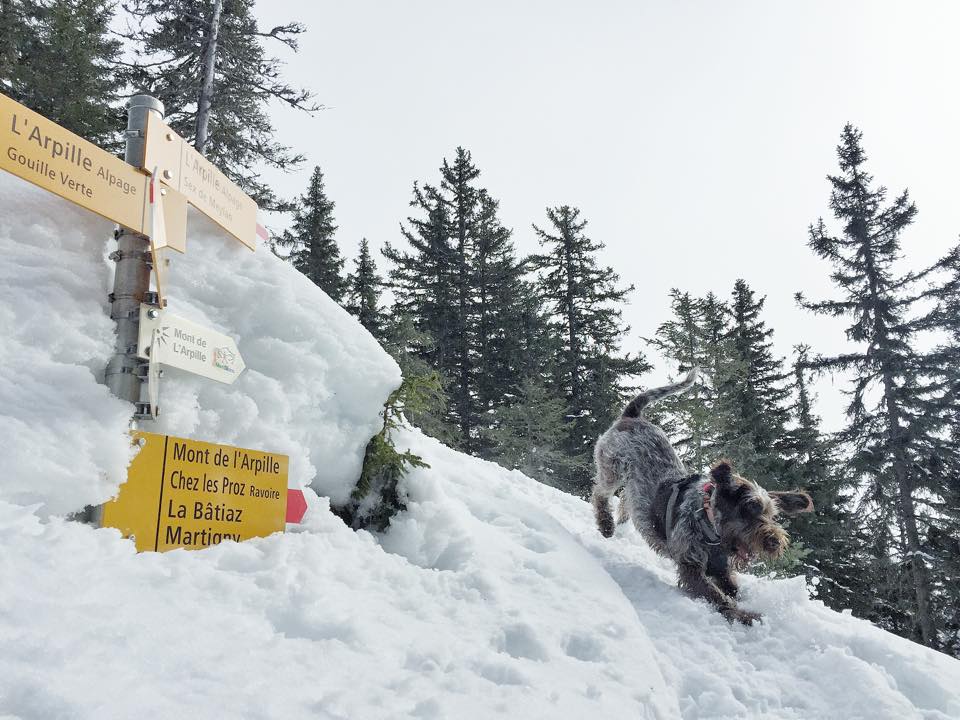

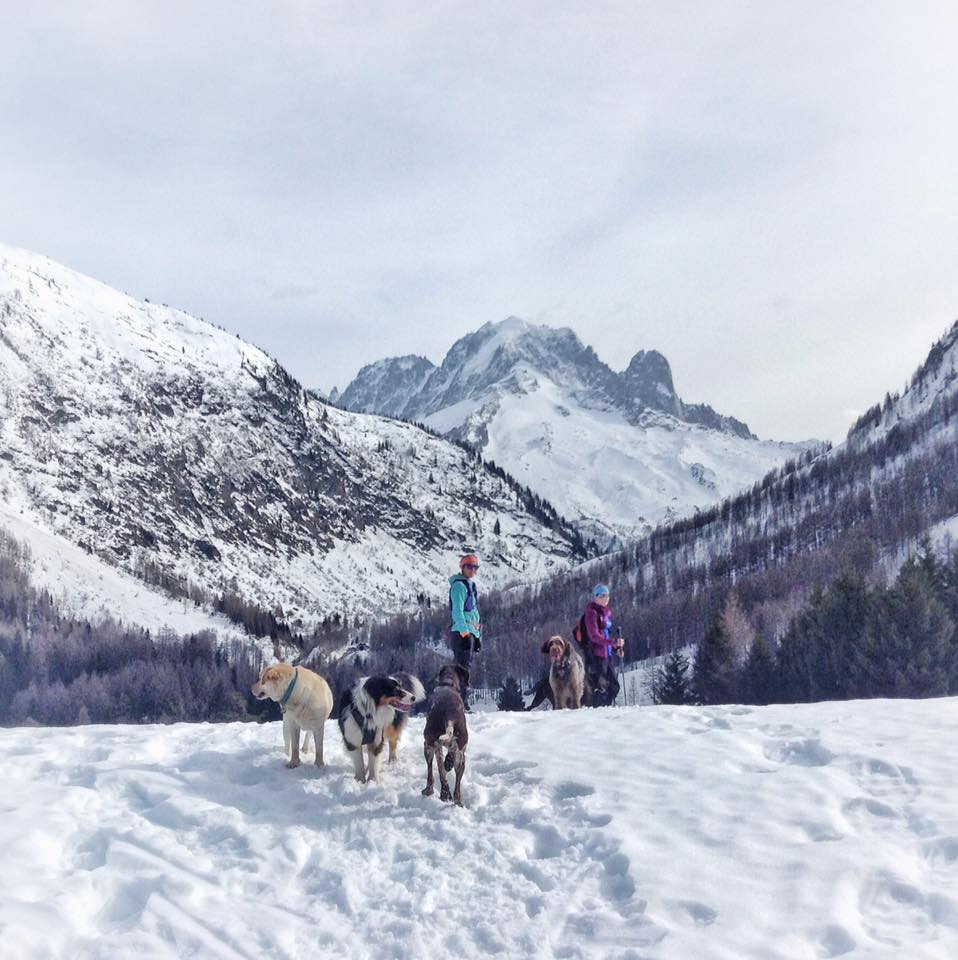
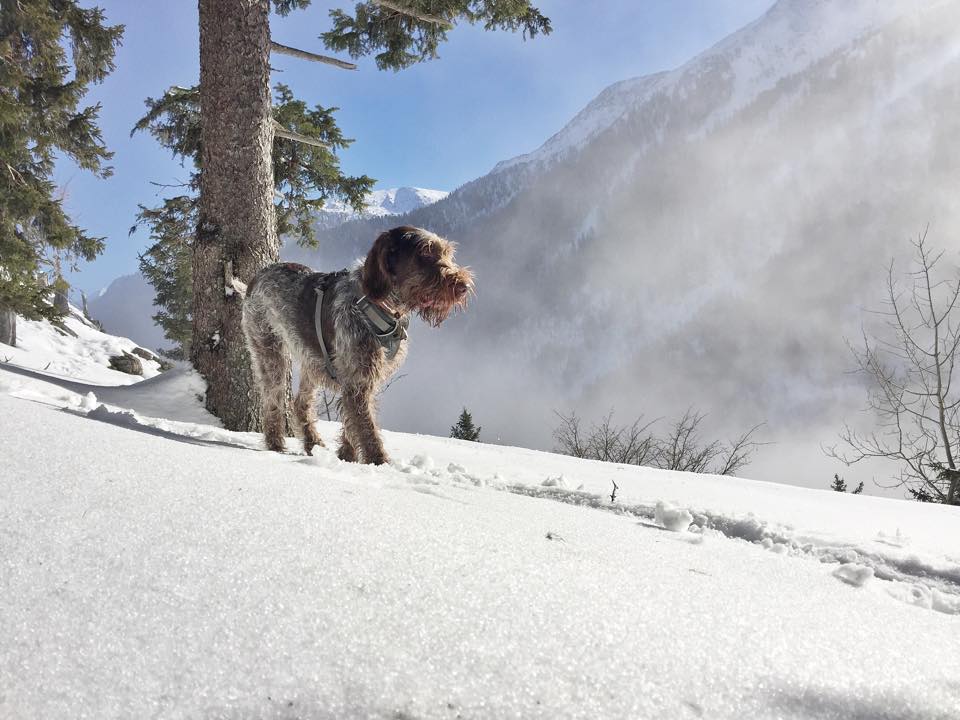
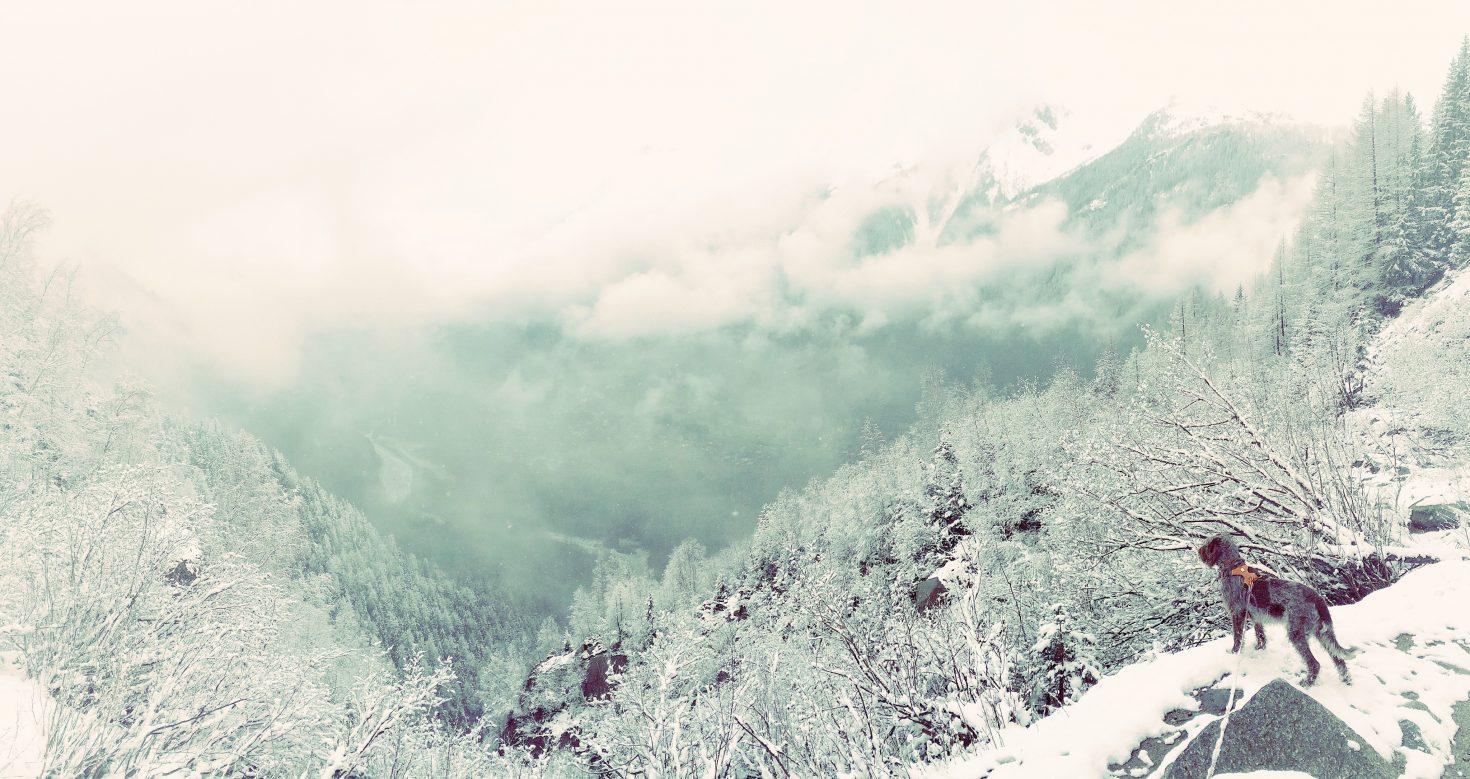
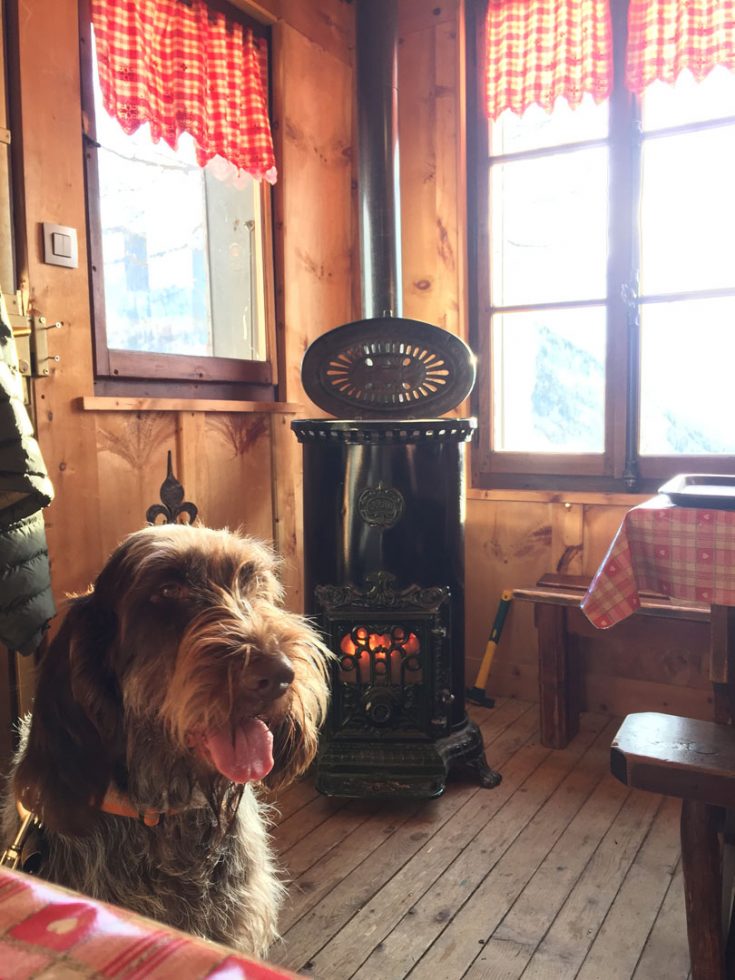
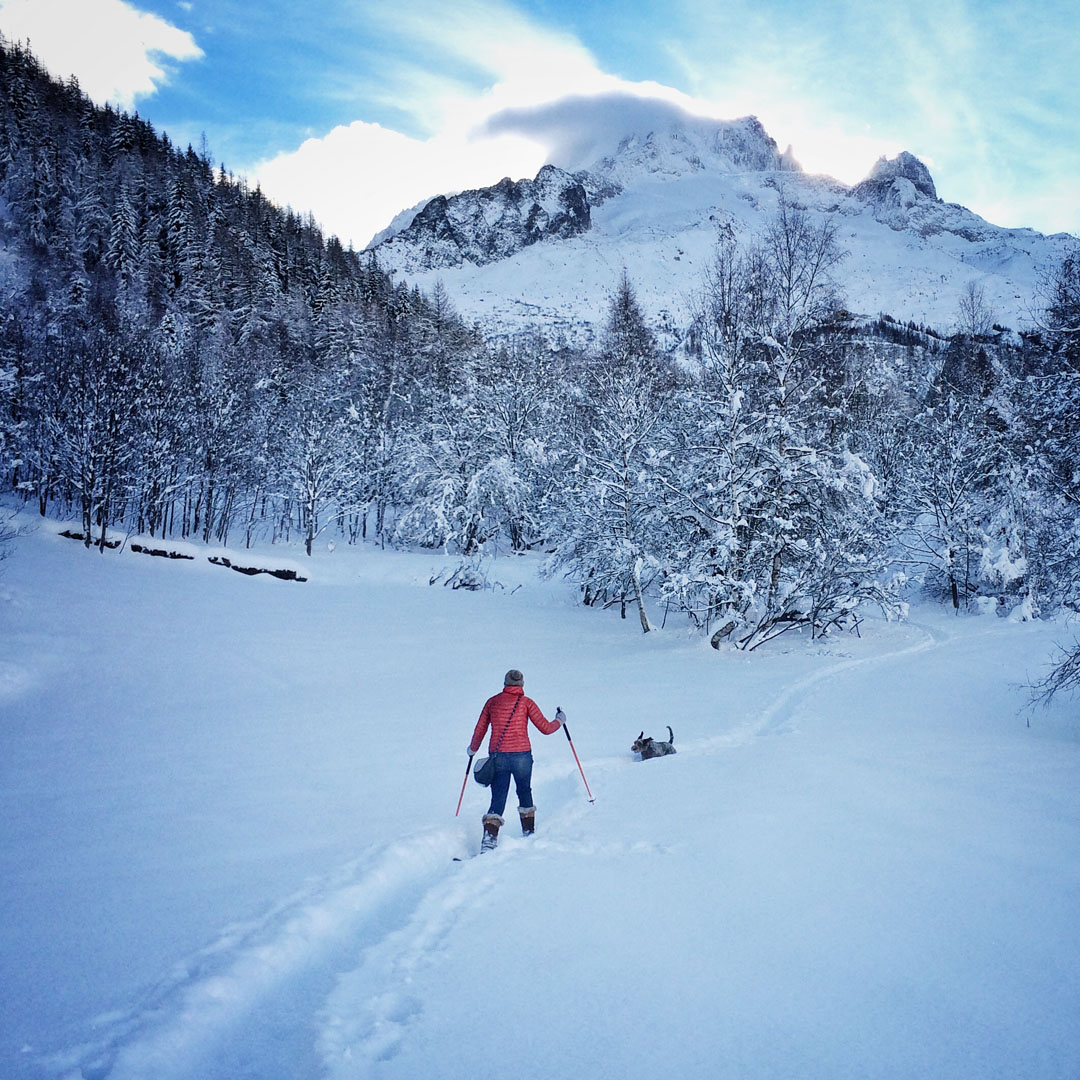
Taking dogs on the lifts.
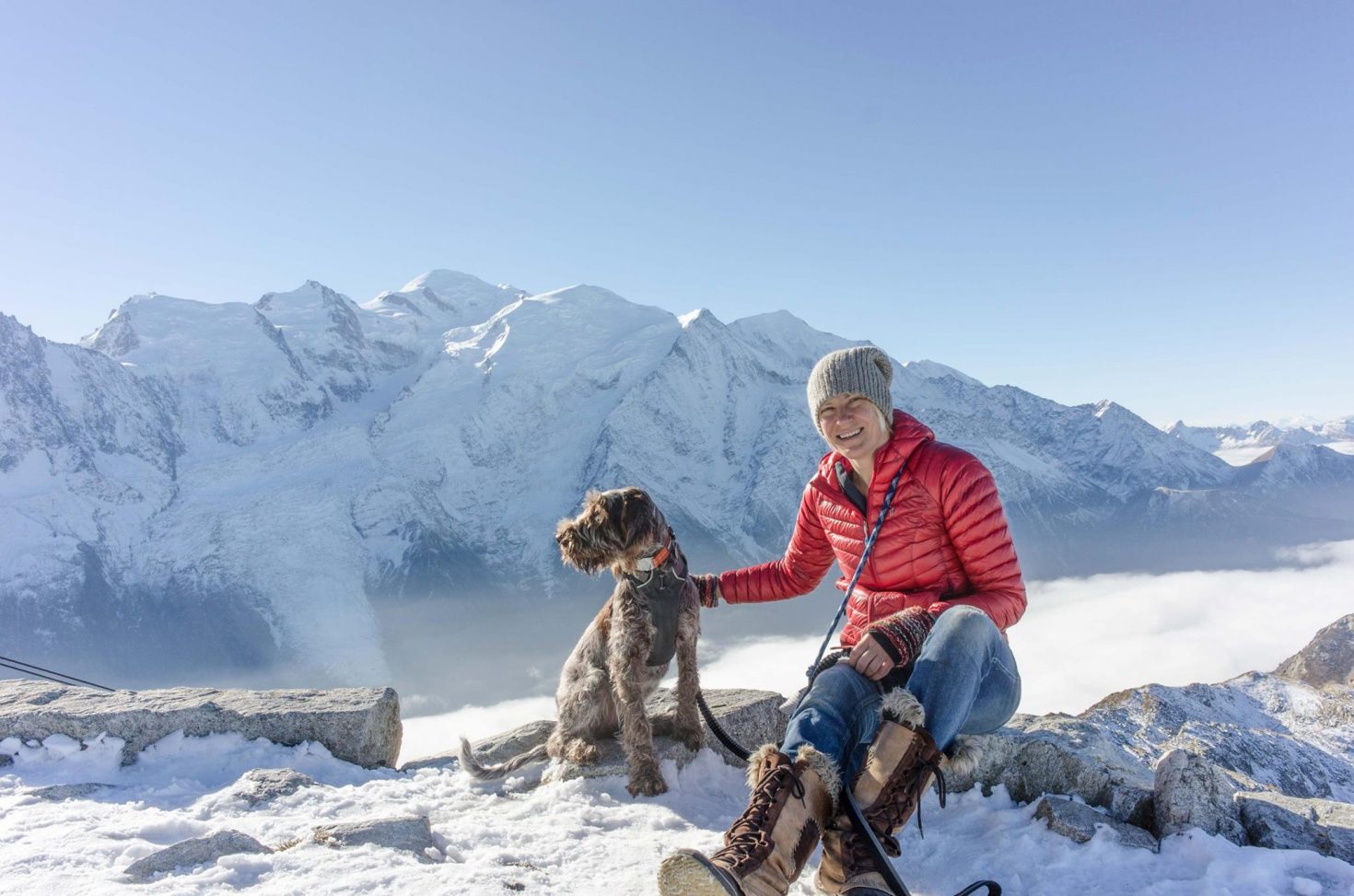
You’re allowed to take dogs on some of the lifts in winter, only as a pedestrian (Brevent, Flegere, Le Tour, Vallorcine, Prarion). They need to be kept on a lead as you’ll be in the ski area, and remember to bring poop bags! There aren’t many walking possibilities from the lifts so this is more for sightseeing than anything else, though you can take them on the lead along the lower snowshoeing path from Flegere, and also from the Prarion to the Prarion summit . I strongly recommend a harness as well, as all these lifts will take you to areas where there are very big drops, snow filled gorges or other dangers.
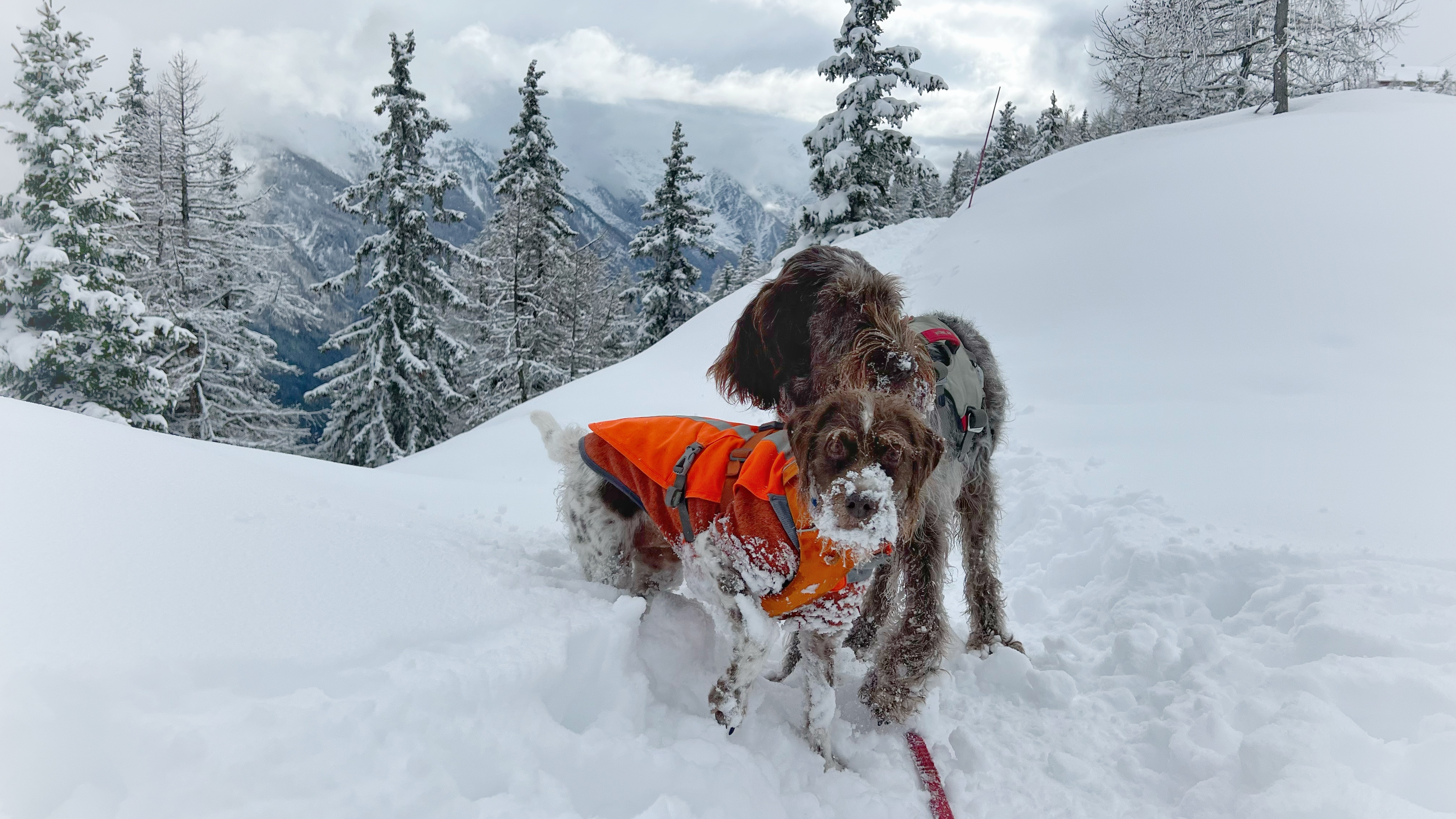
You can also take dogs on the Montenvers railway – if there isn’t too much snow this can be a nice place to walk.
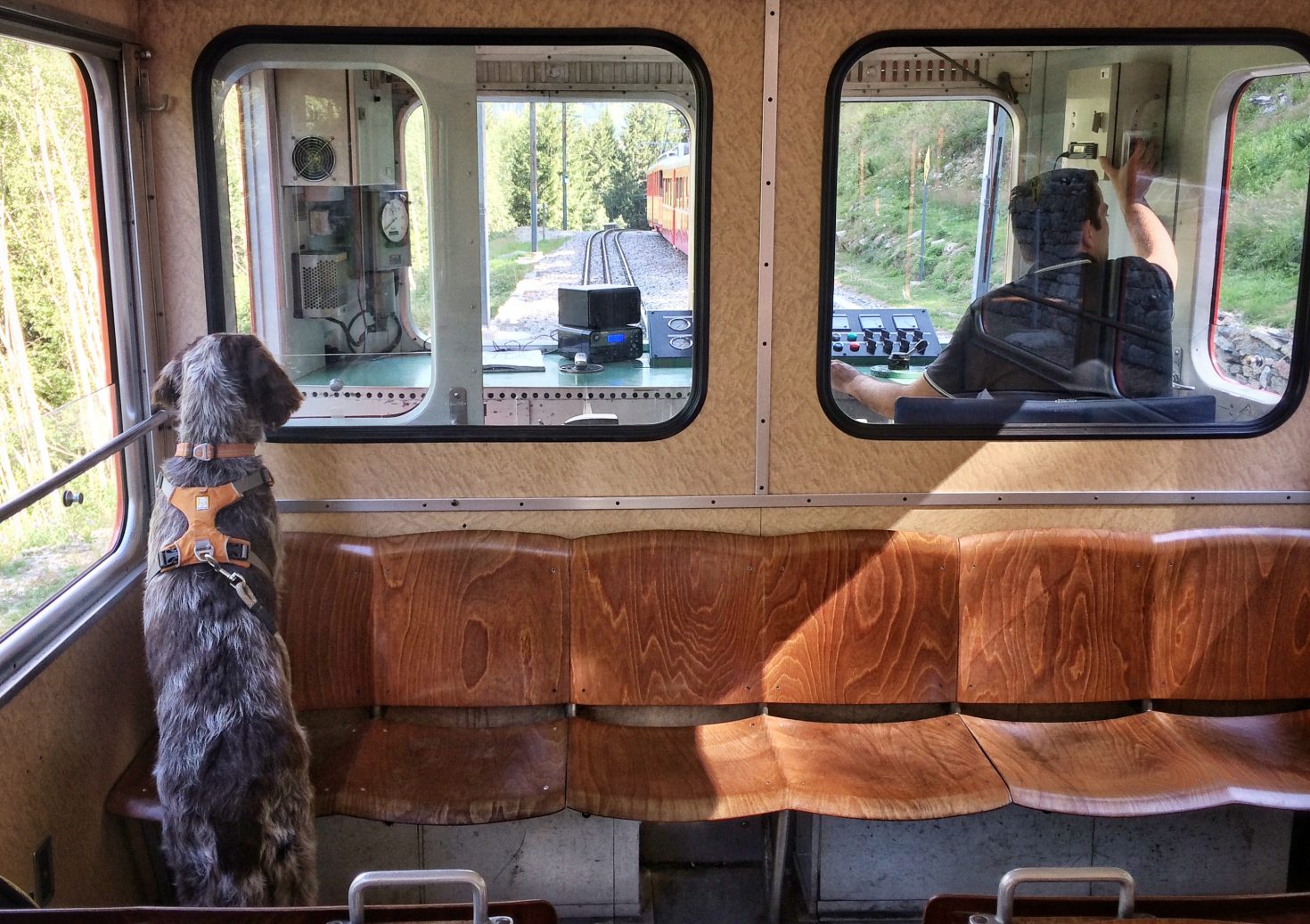
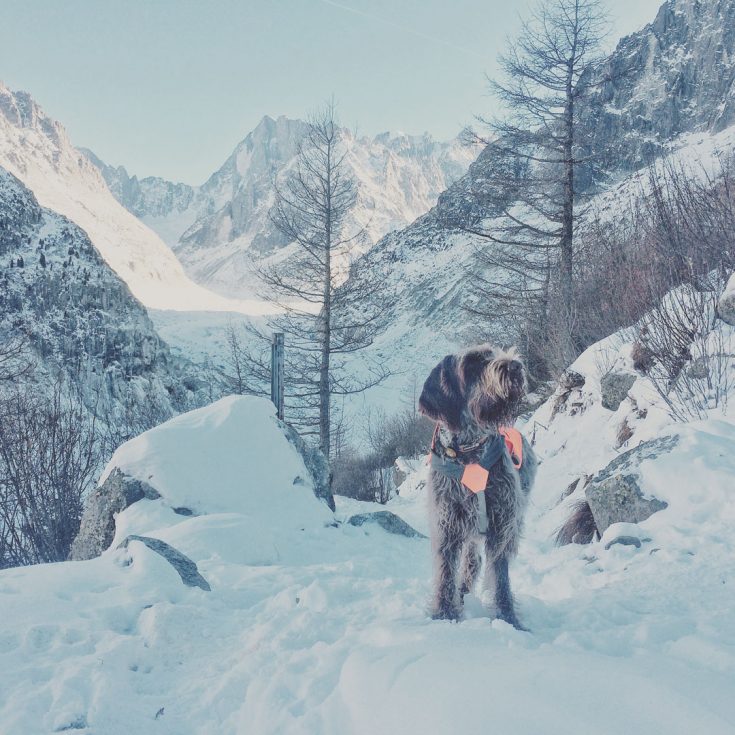
Skyway Monte Bianco
This is the equivalent of the Aiguille du Midi on the Italian side, through the Mont Blanc Tunnel. You are allowed to take dogs on it! Dog ticket is 7€. You need a muzzle as on all public transport in Italy – in practice I find a figure 8 lead, Halti, Dogmatic or similar headcollar is accepted. See their site for details and opening dates – it is often open when the Midi is closed so can be a good off-season option. It is well worth the elevator and walk (almost all inside) to the old Rifugio Torino if open, to experience a more old-fashioned side of mountain exploring. They do nice polenta here too. NB I would not do this without a very secure harness on the dog.
Courmayeur on the Italian side is a fun experience in its own right and it’s worth stopping in at either the upmarket delis in the town or a supermarket outside it to pick up fabulous Italian food at very reasonable prices.
If someone in the car has an MBU ski pass you get a reduction on the Mont Blanc Tunnel. Well worth having. Ask when you buy the ski pass as conditions apply.
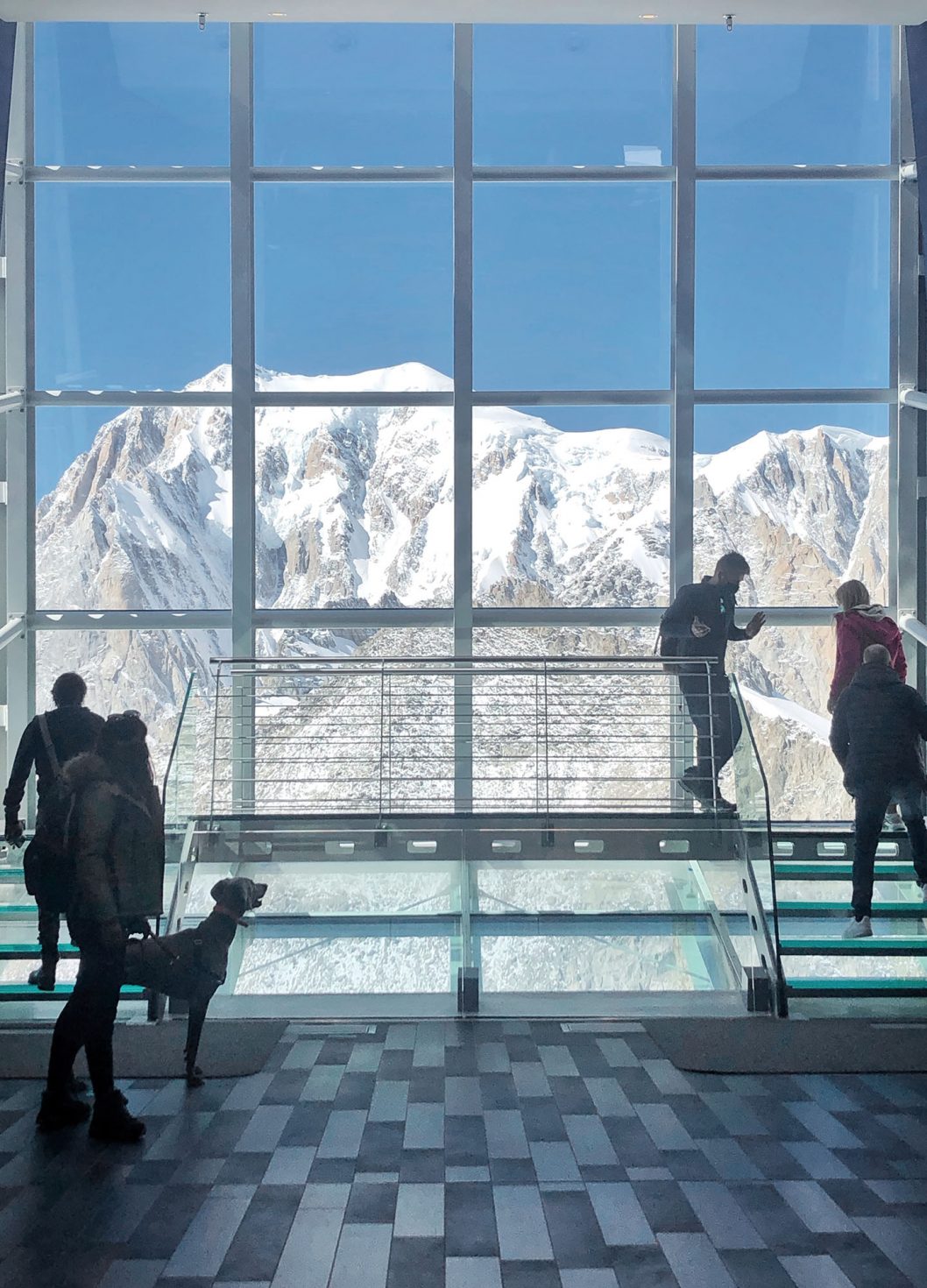
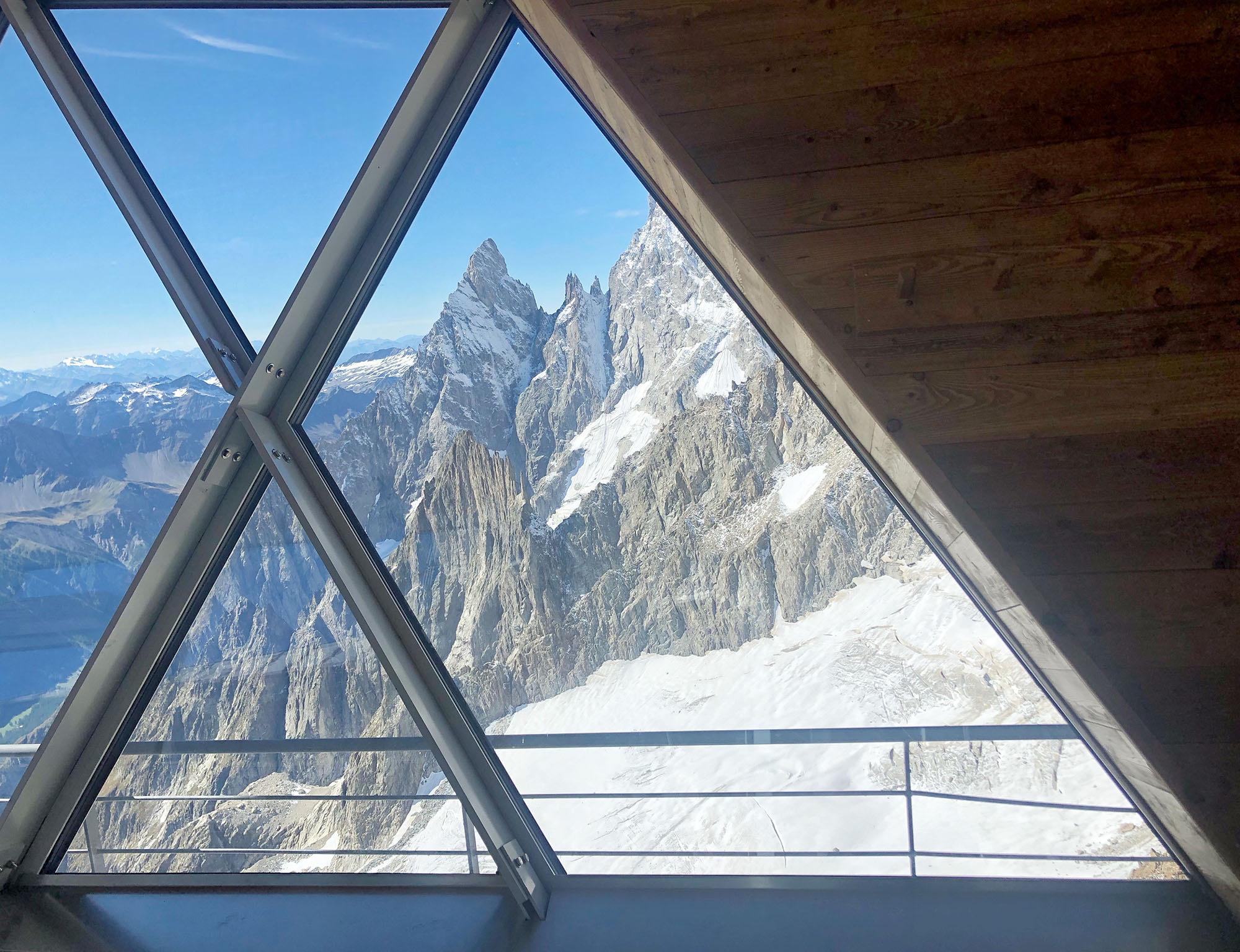
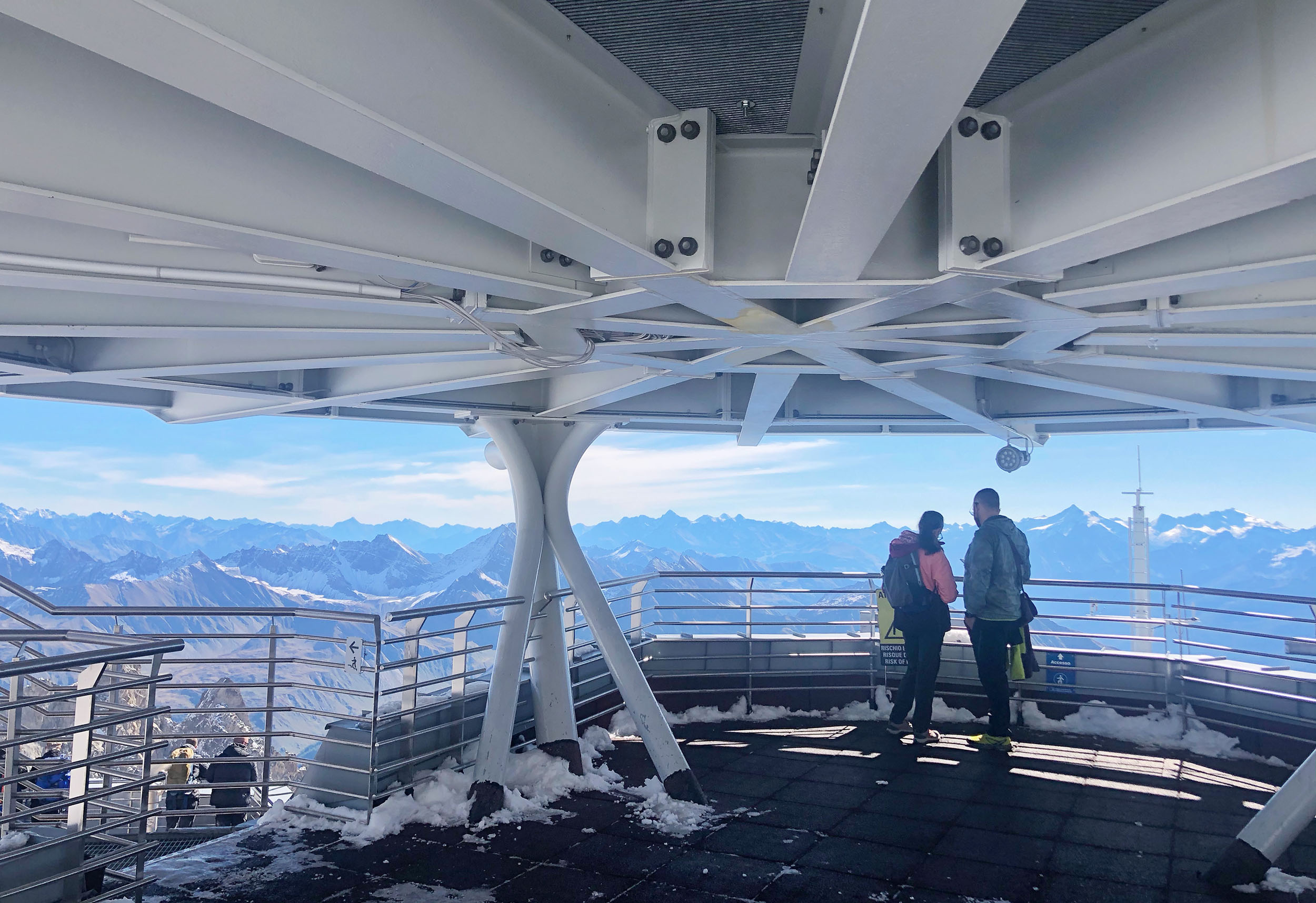
Ski touring with a dog
Many dogs love ski touring! However preparation and training is vital.
As with anything, start small. You don’t want to find problems three hours into a big ascent. Do some high snowy walks or snowshoeing first.
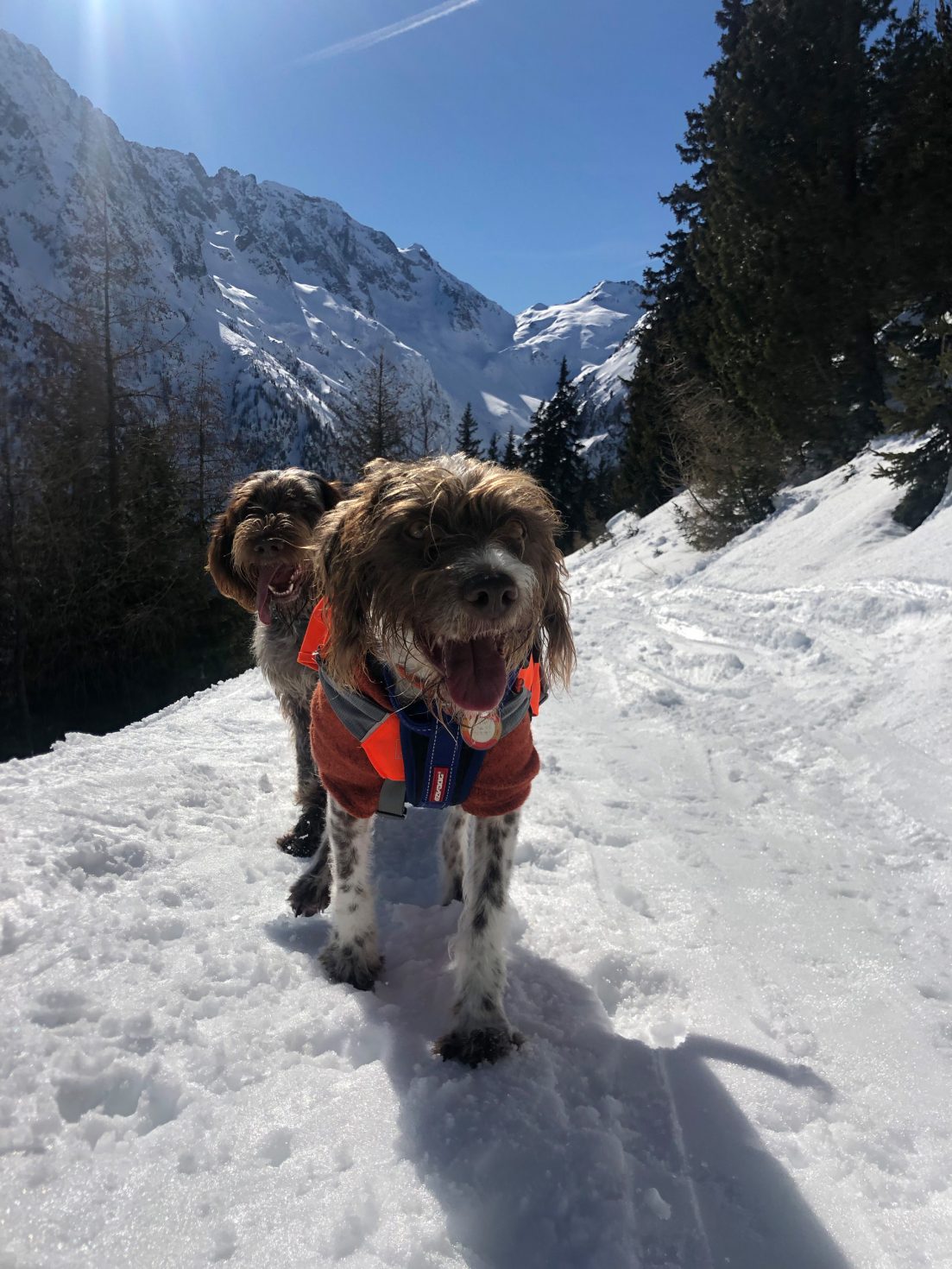
Ski Touring Training:
Don’t neglect the fundamentals – if you are unsure that they will recall properly, they should not go touring at all. Remember that they could put not just themselves but you and other parties in danger if they run out of control and have to be searched for, or fall into a hole, or even release a slope. Remember that you may see wildlife such as chamois on ski tours.
Start well in advance – ski touring training takes some time.
Do some training first in a safe area. A sloped field is a good place to start, to see how your dog reacts. Teach them to keep well clear of the skis – a pole is useful for this – as there have been very nasty accidents with legs getting sliced by skis. Dogs can sometimes tend to follow very closely in the skin track and need to learn not to do this in case a ski slips back.
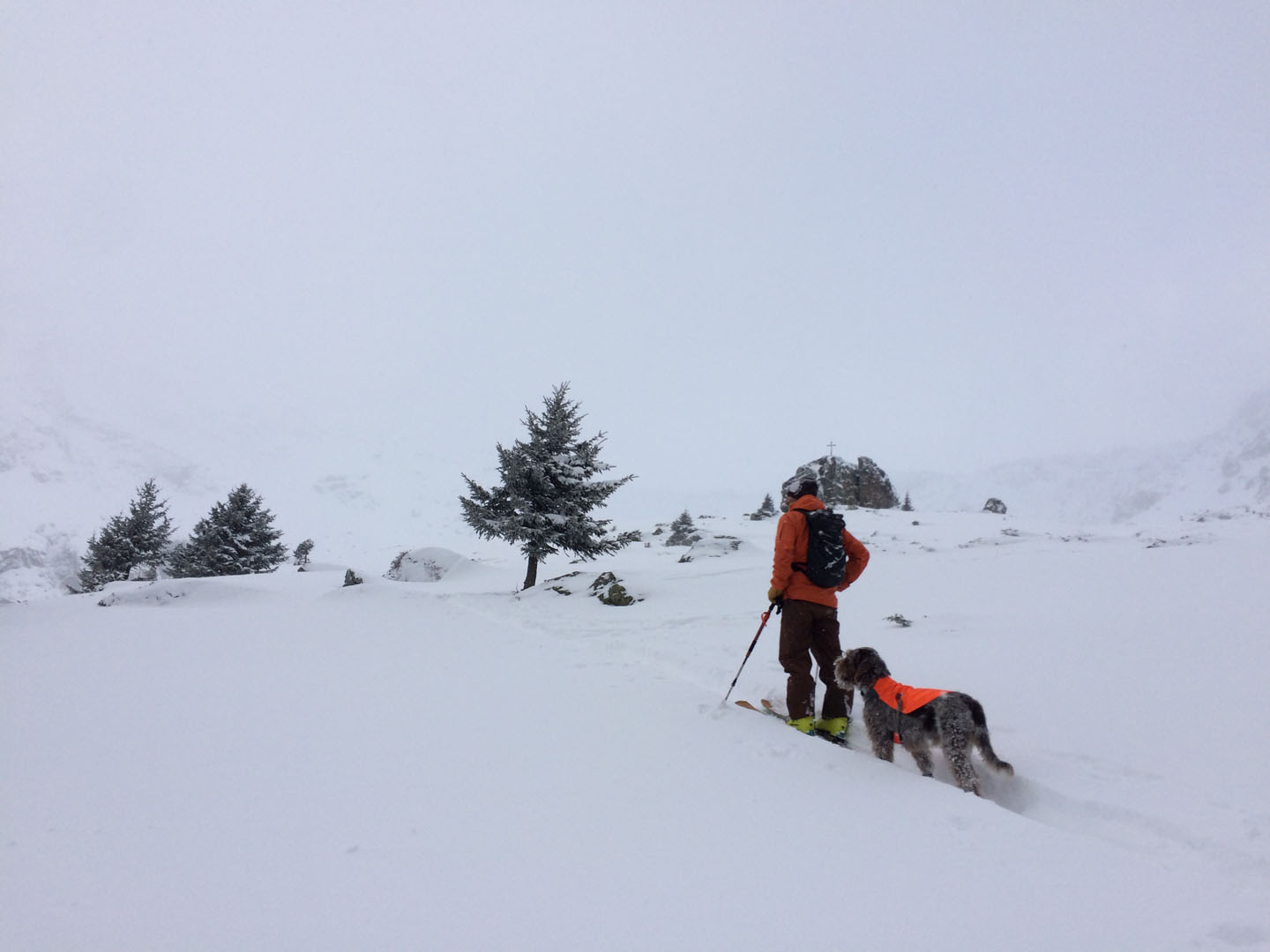
Small to medium sized dogs can go in your backpack in case of emergency, and you should accustom them to this. If not, consider how you would get it down the mountain in an emergency. Helicopters will not always come out for injured dogs. Research (and test) how to carry your dog according to its size, if injured.
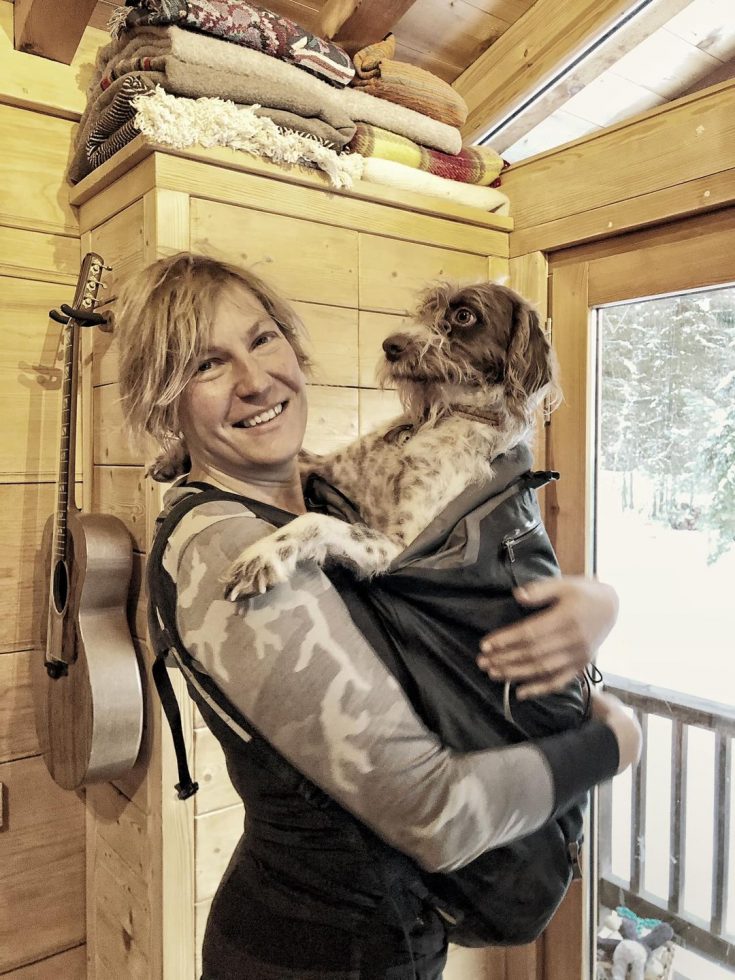
Ski Touring Kit
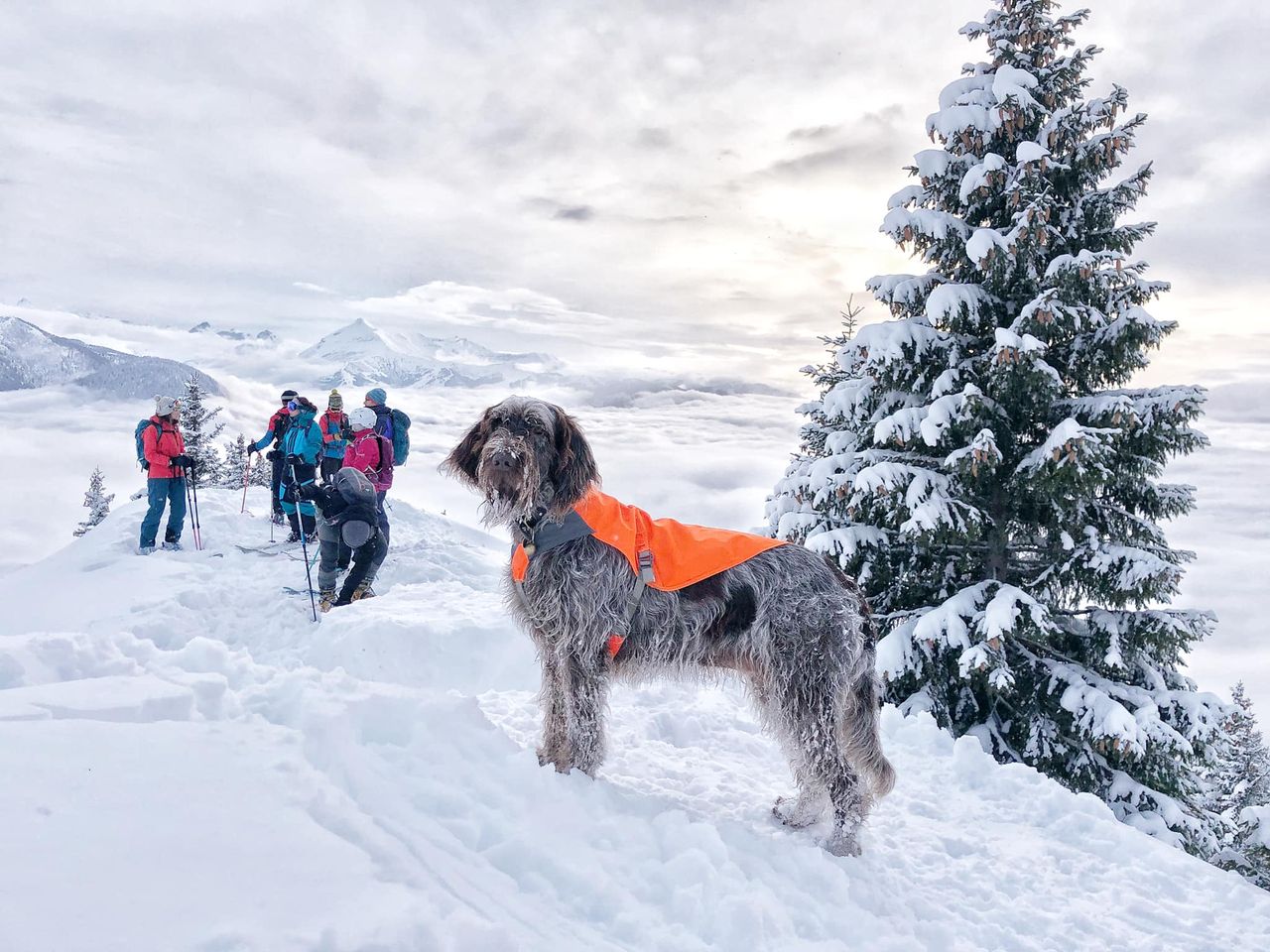
The dog’s usual winter gear may not be enough on a long ski tour. Even if your dog normally doesn’t need a coat, things may be different after a long walk in the snow at altitude – especially as the uphill pace is not fast for a dog. It’s a good idea to have something warm if needed, especially on breaks and in case of emergency. A child’s down gilet can be an excellent inexpensive and lightweight emergency warmer for a dog.
We use visibility jackets and bells when ski touring – people skiing down can be moving very fast and are not normally looking out for a dog coming up. A clip on light (Ruffwear or Orbiloc are good brands) or light up collar is a good idea in case of a late return in low visibility.
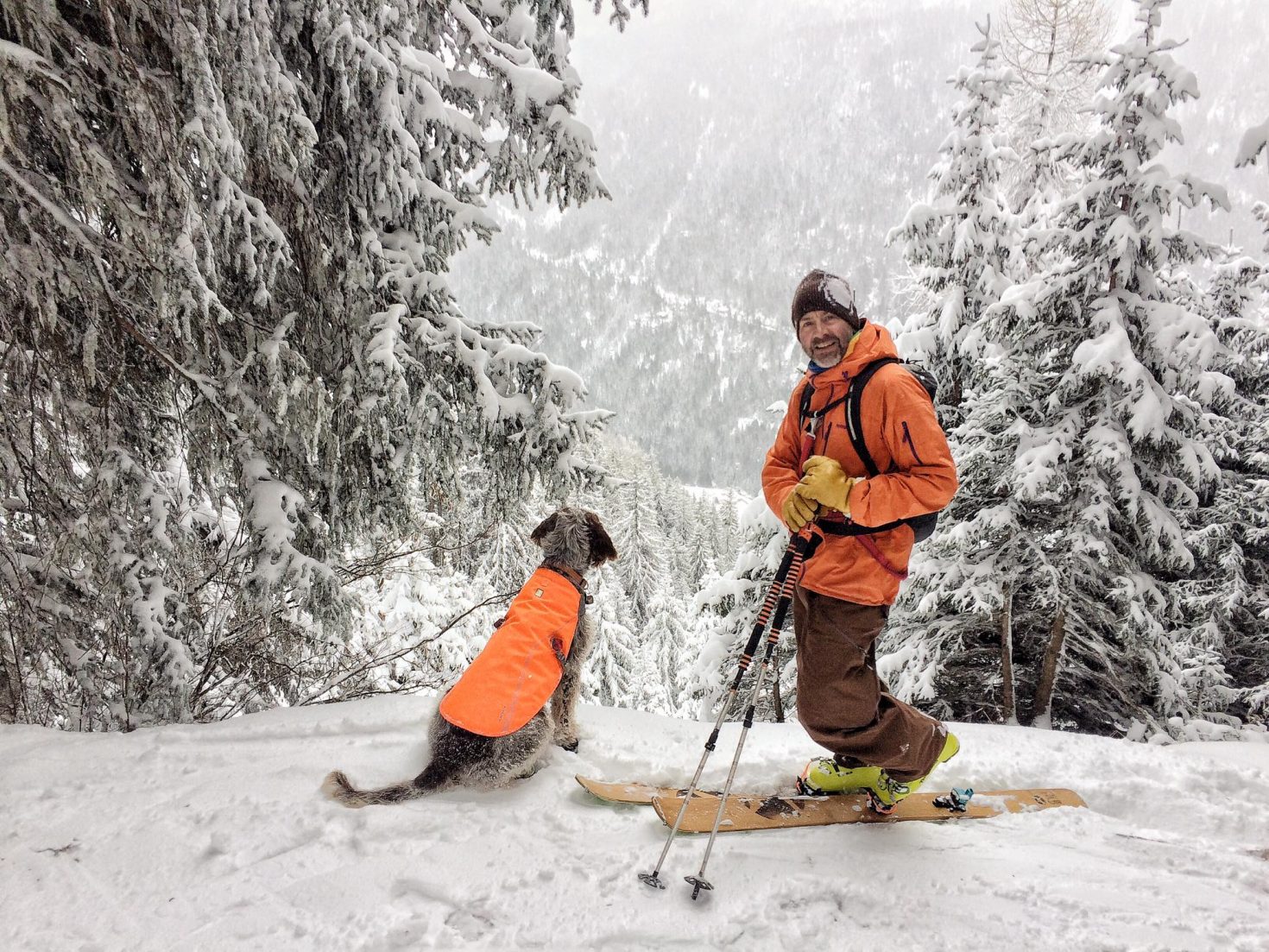
Some dogs do fine without boots, some won’t wear them and some really need them. Bear in mind that with boots they do lose a bit of the grip as they can’t use their claws. They need to get used to this before confronting steep or slippery conditions.
First, see if you need them on some long snowy walks or by snowshoeing. Then start by getting the dog used to them. There is plenty of advice for this online…read through a few and see what works best for your dog. Don’t expect to just put them on and set off on your skis! You can often buy socks to go with them which may sound eccentric but it can make them a lot easier to get on.
Keeping the fur short between the toes and using paw wax is enough for some dogs – Alissa does just fine as she is. Daphne’s big webbed paws get terribly balled up in some types of snow so she needs boots or we are stopping every five minutes to get lumps of ice out of her feet.
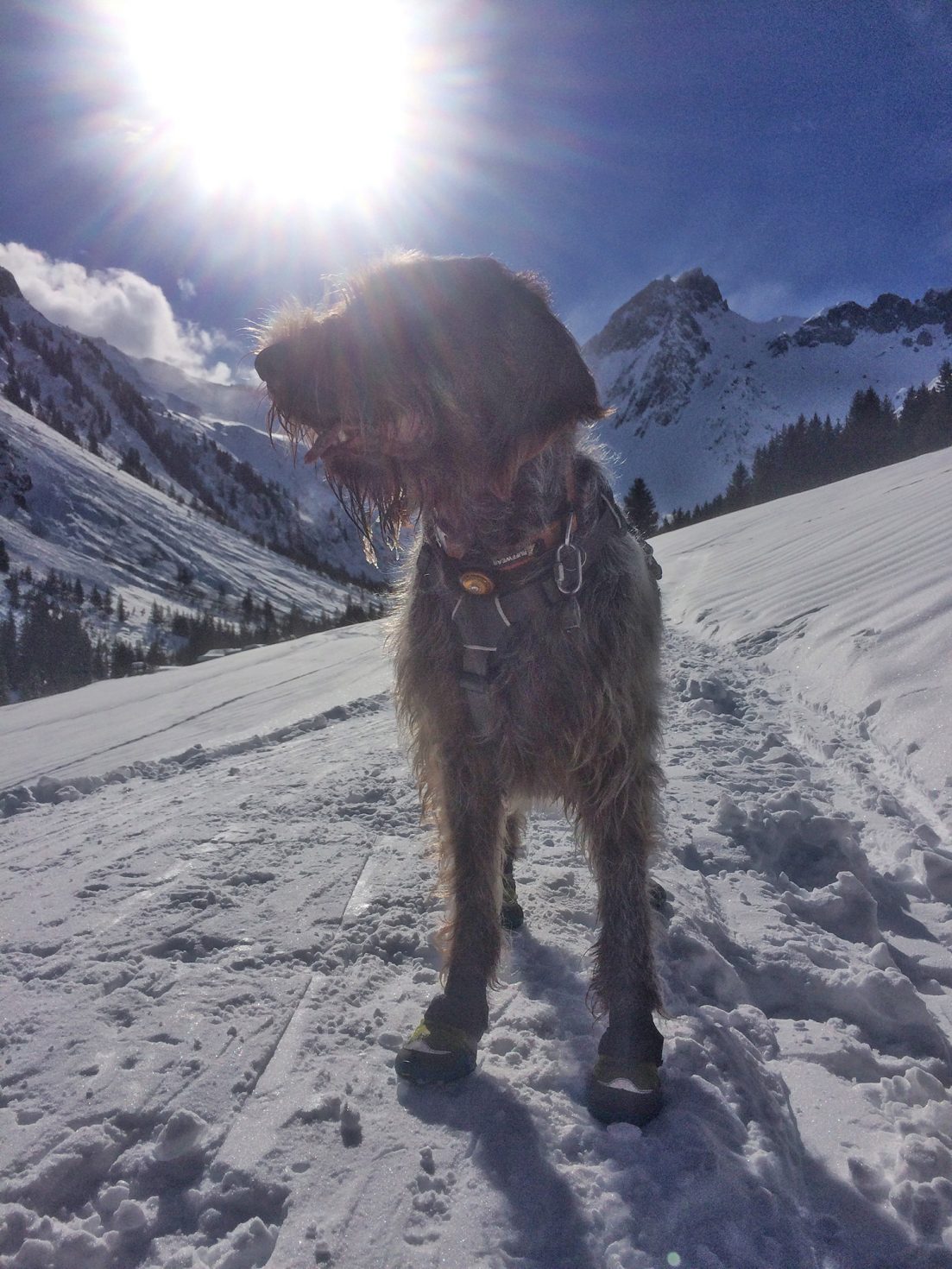
You may need a lead at some points – it’s always best to have one. It needs to be long enough that the dog is well away from the skis. Ruffwear make a good one with an elasticated section which can also be worn around the waist to keep your hands free.
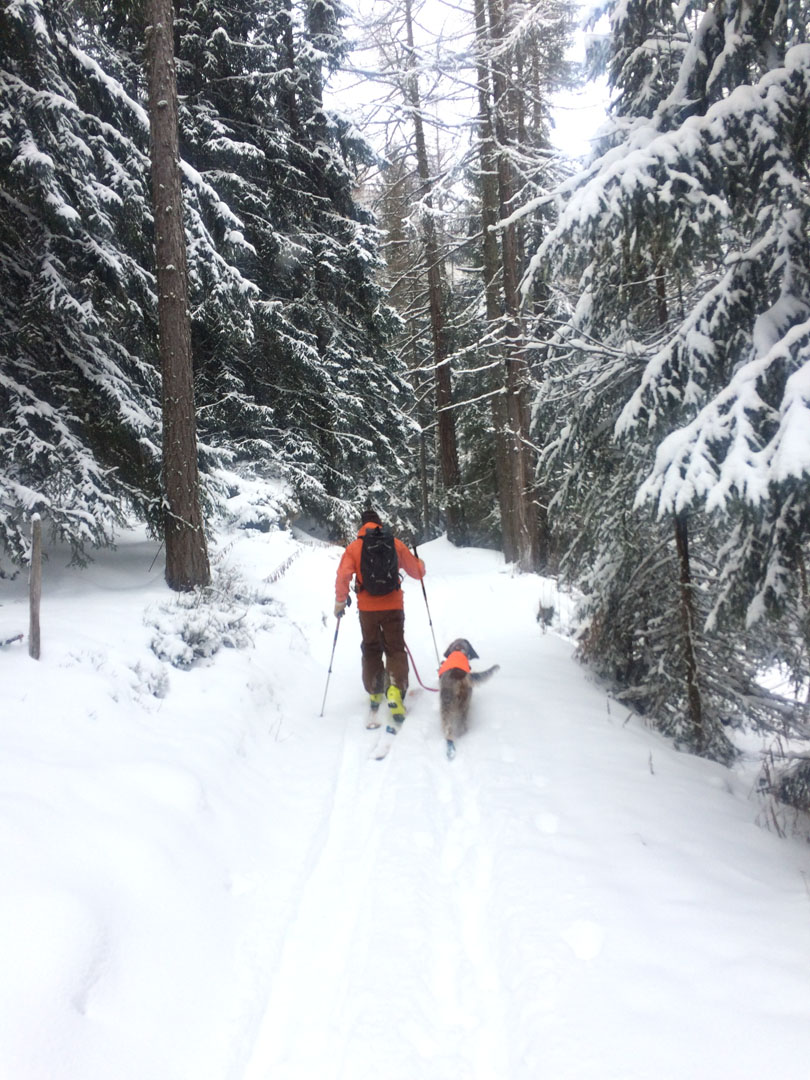
Allow for some water in your bottle for them or pack extra for them, with a light bowl to drink from – a waterproof stuff sack does well for this. Pack some dry food for treats and emergencies.
It is always important to remember that if you lose your dog in the high alpine in winter, it may well not survive the night. Ours wear GPS trackers for extra safety in case of unexpected events. Make sure both the trackers and your phone are fully charged in case of need, and have your vet’s number plus local vets in your phone in case of need.
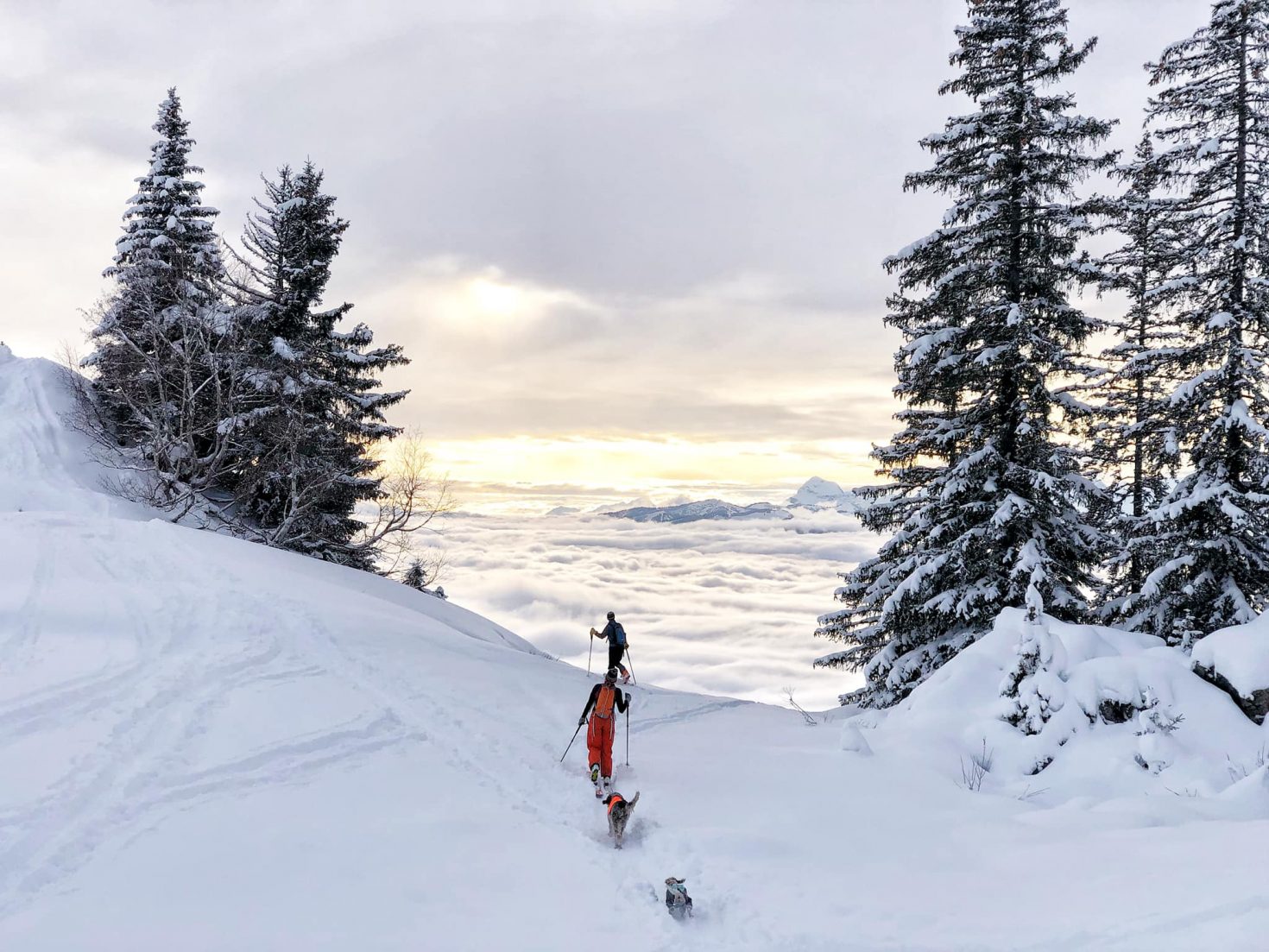
Avalanche beepers for dogs are something of an ethical issue. In the US it’s possible to buy avalanche beepers on a different frequency that can be used for snowmobiles and dogs. I have never seen them in Europe and have been told that it’s because they cannot be guaranteed not to be used by people as a cheap option. However the real answer to avalanche safety for dogs is that they should not ever be taken on tours where there is any risk of avalanche. This brings us to…
Route Choice
Not every ski tour is suitable for a dog…just as not every dog is suitable for ski touring. It’s important to adjust your expectations…if it’s going to be a fabulous powder day when you’ll want to get in the steep and deep, it’s probably a day to leave the dogs safe at home or with a dog-sitter (see Summer page) .
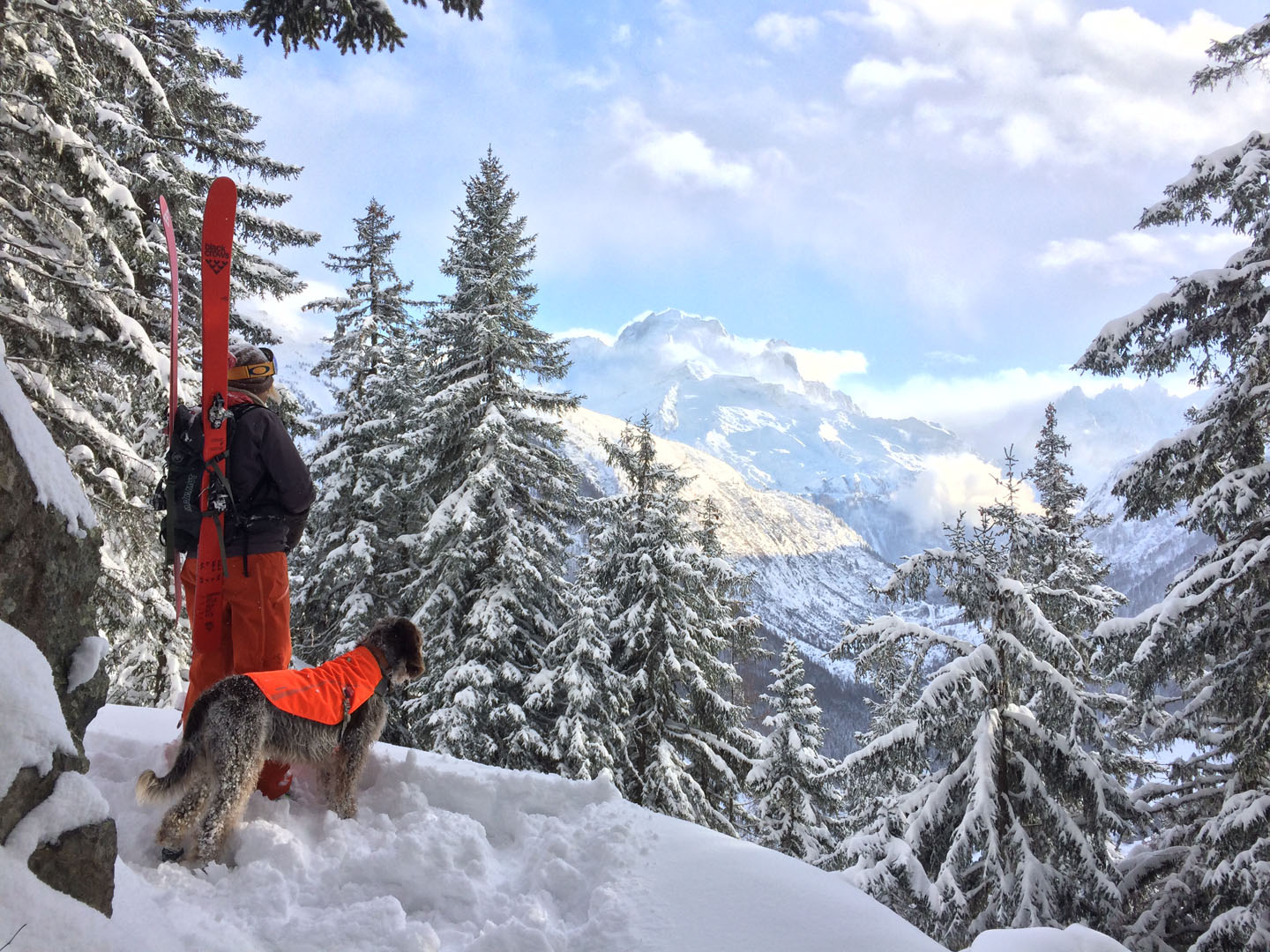
Avoid busy times. New Year and Christmas are not great for ski touring with a dog, especially for the first time, as there can be a lot of inexperienced parties descending. Snowshoeing is a better option at these times.
In Chamonix the best option for wooded easy tours are places like Loriaz or Col de Forclaz. (NB Do not skin up the signed trails within the ski areas with a dog! )
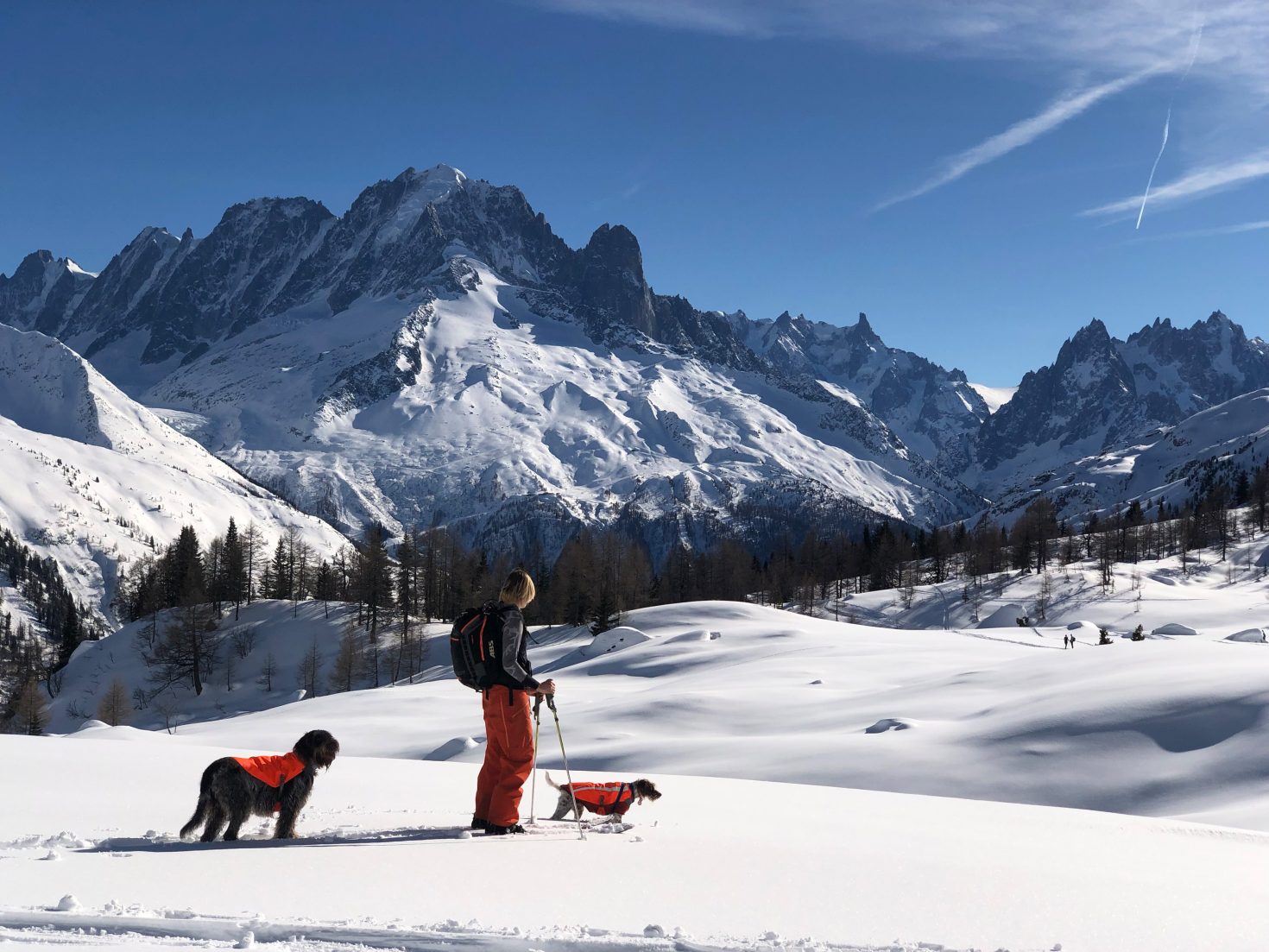
Be considerate – pick up any mess that your dog leaves on the path. Keep an eye on your dog – if they begin to get tired and cold, don’t hesitate to turn around.
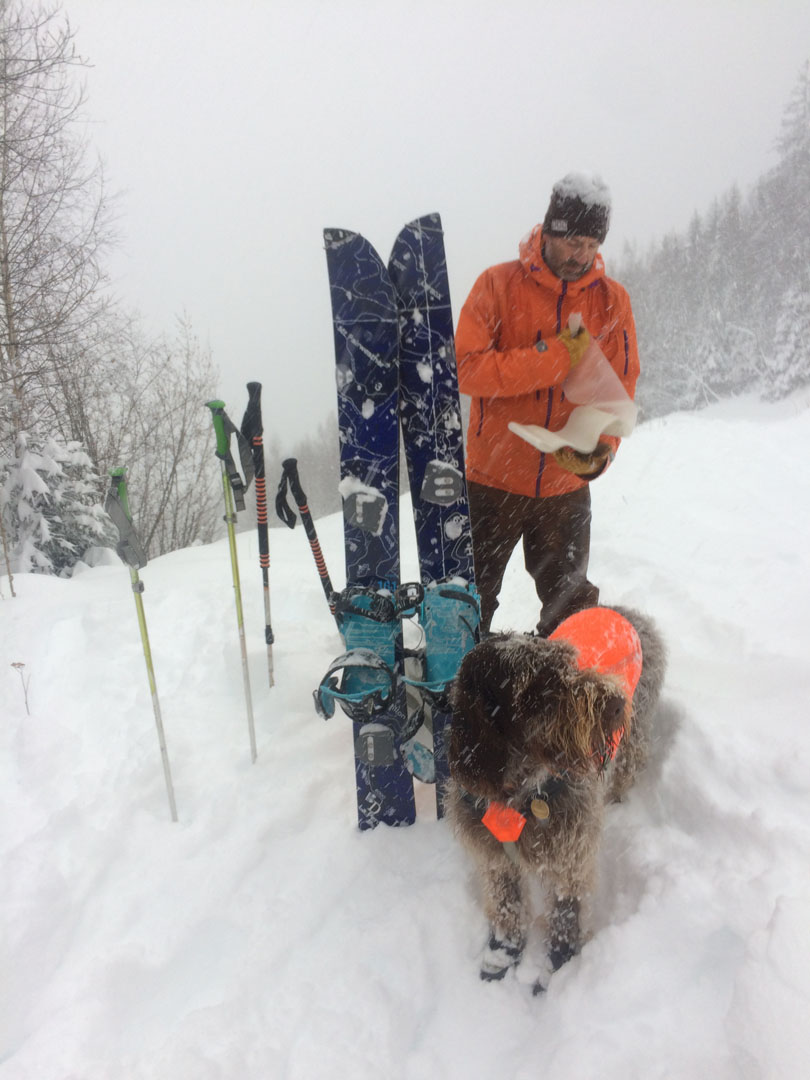
After a long tour even the most enthusiastic dog can be tired, wet and cold – it’s good to have some towels in the car and perhaps something warm for them to travel back in.
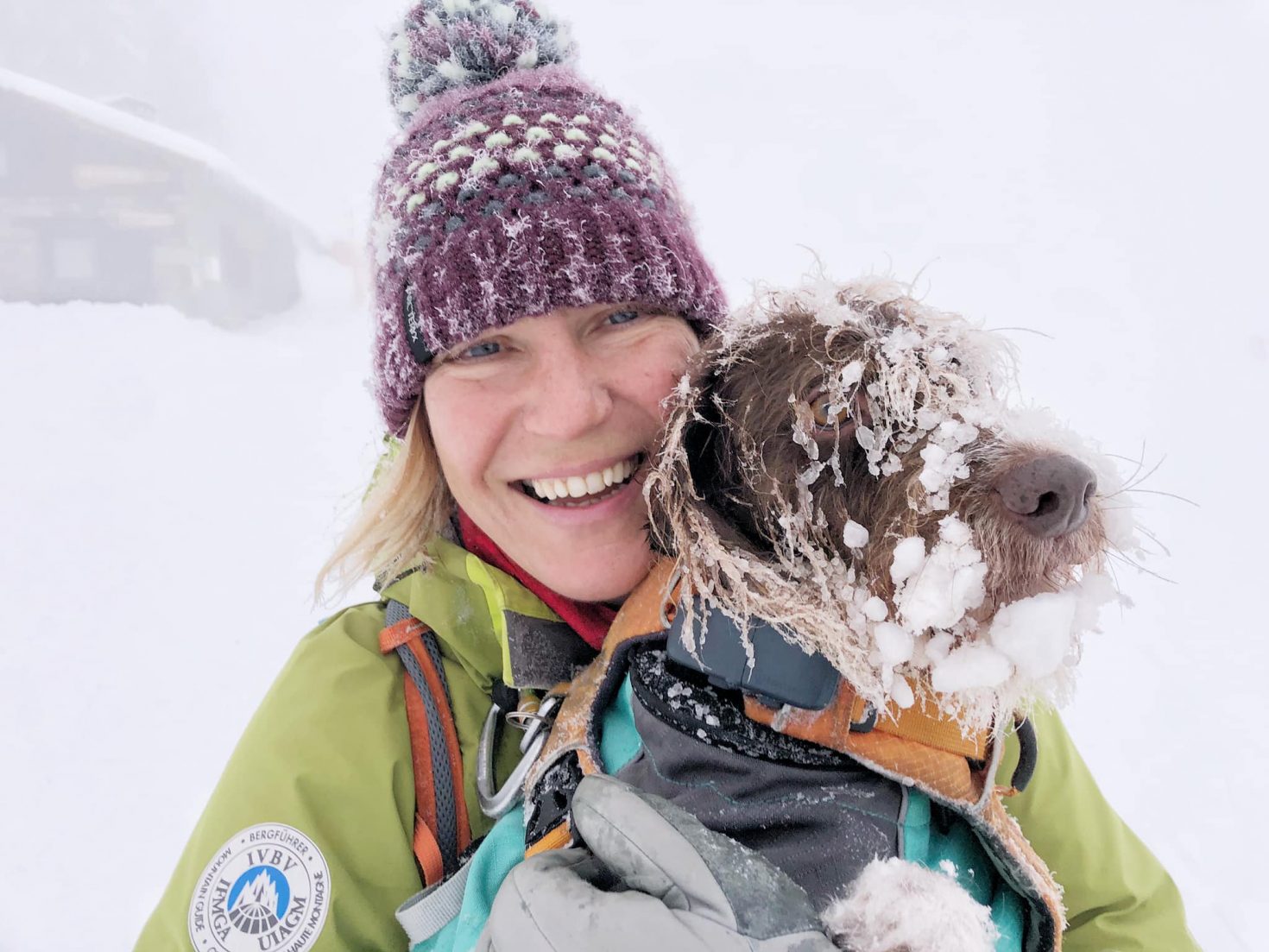
Don’t forget to read the Chamonix for Dogs in Summer page for additional general information, vet numbers and so on.
Thanks for reading all this, I hope it’s useful for you! We do accept dogs at La Petite Forêt, on request and with some (reasonable!) rules so do contact us if you’re interested in visiting 🙂
And have a great time with your dog in Chamonix!
